Published May 6, 2020
Index:
1. Alternate-leaved Dogwood: shrub or small tree with a low, horizontally spreading crown, and dark green lance-shaped leaves
2. American Beech: broad crown, dense, sturdy canopy, and large, oval leaves with straight veins
3. American Elm: fountain or vase-like shape, dark green oval, tough and asymmetrical pointed leaves
4. American Mountain Ash: rounded foliage, lance-oblong, dark green leaves, white flowers in the spring, or red or orange berry-like clusters of fruit
5. Balsam Fir: tall and narrow, growing into a skinny, spire-like tip at its highest point with shiny dark green needles
6. Balsam Poplar:tall and somewhat slender with a thin trunk and shiny, pointed, oval-shaped leaves
7. Bitternut Hickory: tall and oval-shaped with light green, lance-shaped leaves
8. Black Walnut: low branches and an open crown that gives a round shape and oval-shaped single leaflets
9. Black Willow: irregular crown and narrow, long, and pointed leaves
10. Bur Oak: often tall with a straight trunk and large shiny green leaves with lobes and variable shapes
11. Butternut: wide foliage that branches out and lance-shaped leaves that bear large, cylindrical nuts
12. Chokecherry: oval or round shrub or a small tree with broadly oval leaves with short tip and tiny teeth
13. Eastern Hemlock: conical with shiny green needles with pale undersides
14. Eastern White Cedar: conical shape with densely layered, arching branches that grow scale-like yellowish-green leaves
15. Jack Pine: irregular, spreading shape with light yellowish-green needles
16. Red Mulberry: rounded foliage with large, rough, oval-shaped leaves and red or dark purple berries that look like stretched out blackberries
17. Sassafras: tall and bushy shrub or tree with varied leaves, which can be oval-shaped, mitten-shaped, or three-lobed
18. Sugar Maple: round and full with smooth and yellowish-green leaves with 3-5 pointed lobes
19. Sycamore: very tall with an upright trunk, crooked branches, and round foliage with large, rough leaves with 3-5 lobes and teeth
20. Tamarack: conical with sparse, spread out branches and soft, pliable, green needles
21. Trembling Aspen: slender, straight trunk and narrow foliage with round or oval leaves growing into a sharp tip
22. White Ash: round or oval foliage with branches that have between 6 and 9 dark green leaves with pale undersides
23. White Birch: slim trunk with a narrow, oval or pyramid-shaped crown and triangle-shaped leaves with fine hair underneath
24. White Spruce: large a conical with a narrow crown and stiff, sharp, four-sided bluish-green needles
"This oak tree and me, we're made of the same stuff."
And it’s true. We are made of the same stuff as trees. Our bodies are made up of 60% water, and trees are similarly 50% water. Water is all around us, even when we can’t directly see it.
Not only are we alike in our composition, but we share another intimate connection with the towering plants that surround us. A symbiotic relationship that we so often forget. While we inhale oxygen and exhale carbon dioxide, trees breathe in that carbon dioxide and exhale oxygen.
Trees are everywhere, cycling our water, providing shade, air to breathe, and beauty, too. Trees are the biggest plants on our planet, and with so many different species, it can be hard to know which ones are growing around us.
We are lucky to have an abundance of trees in the Great Lakes region. The glaciers that formed the lakes left behind rich soils that support a wide array of tree life. In fact, Toronto alone has more than 200 different tree species.
Did You Know?
On your next walk, take a look at the trees around you. What do you see?
To help you identify the trees in your area, we’ve created a descriptive list of 24 common Great Lake trees. Download our Backyard Tree Bingo and see how many you can spot!
Here are 24 trees you might see in your backyard or neighbourhood:
1
Alternate-leaved Dogwood (You might also see Eastern Flowering Dogwood):
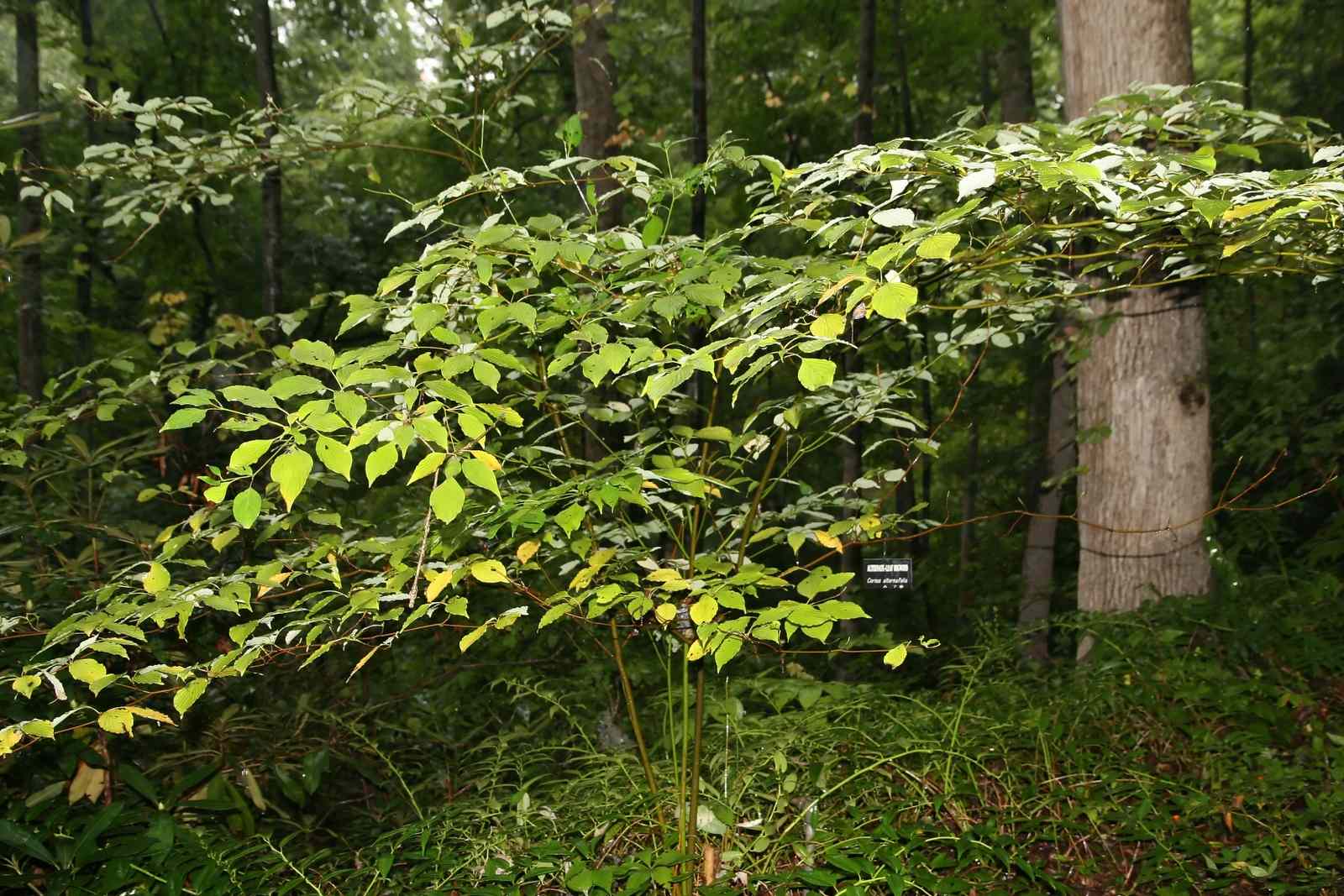
Alternate-leaved Dogwood habitat: understories of forests and the edge of woodlands in southern Ontario
Alternate-leaved Dogwood size: 8-10 meters tall, 5-7 meter spread
Alternate-leaved Dogwood shape: shrub or small tree with a short, slender trunk, flat topped, and a low, spreading crown that extends horizontally with its long branches
Alternate-leaved Dogwood leaves: dark green lance-shaped leaves, white flowers in the spring, and clusters of blue or black berries in the midsummer

Alternate-leaved Dogwood bark: green or reddish brown bark that is rougher in older trees and smoother in younger trees
About Alternate-leaved Dogwood:
- Alternate-leaved Dogwood has alternate leaf arrangement rather than opposite leaf arrangement (like every other type of native Dogwood).
- Summer birds, such as cedar waxwings, American robins, and wood thrushes love to eat the berries.
2
American Beech:
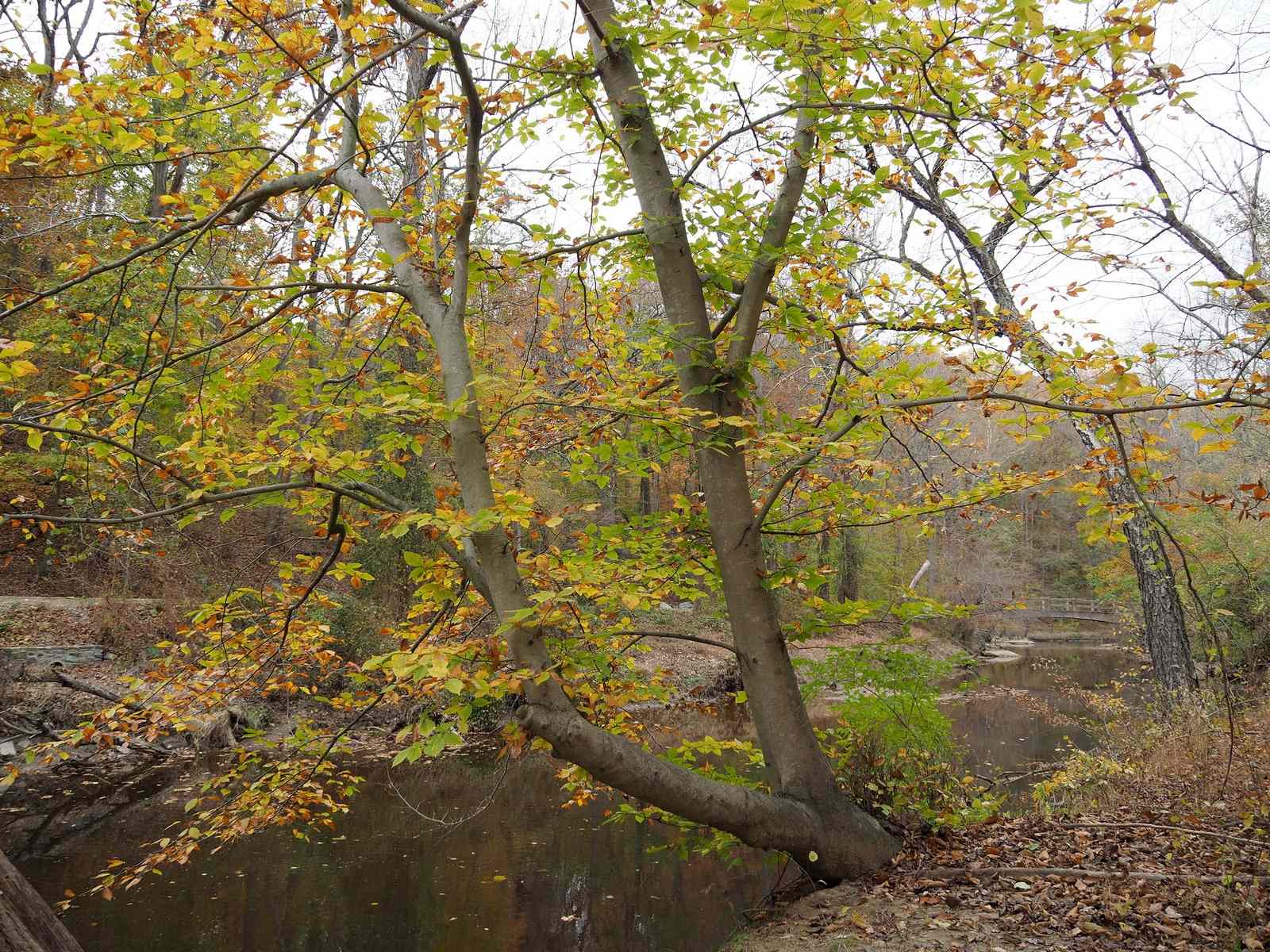
American Beech habitat: forests, bluffs, wooded slopes, riverbanks, and drier areas of swamps in southern and central Ontario, growing as far north as Georgian Bay’s north shore
American Beech size: 20-35 metres tall, 12 meter spread
American Beech shape: broad crown and a dense, sturdy canopy
American Beech leaves: large, oval, alternate leaves with straight veins
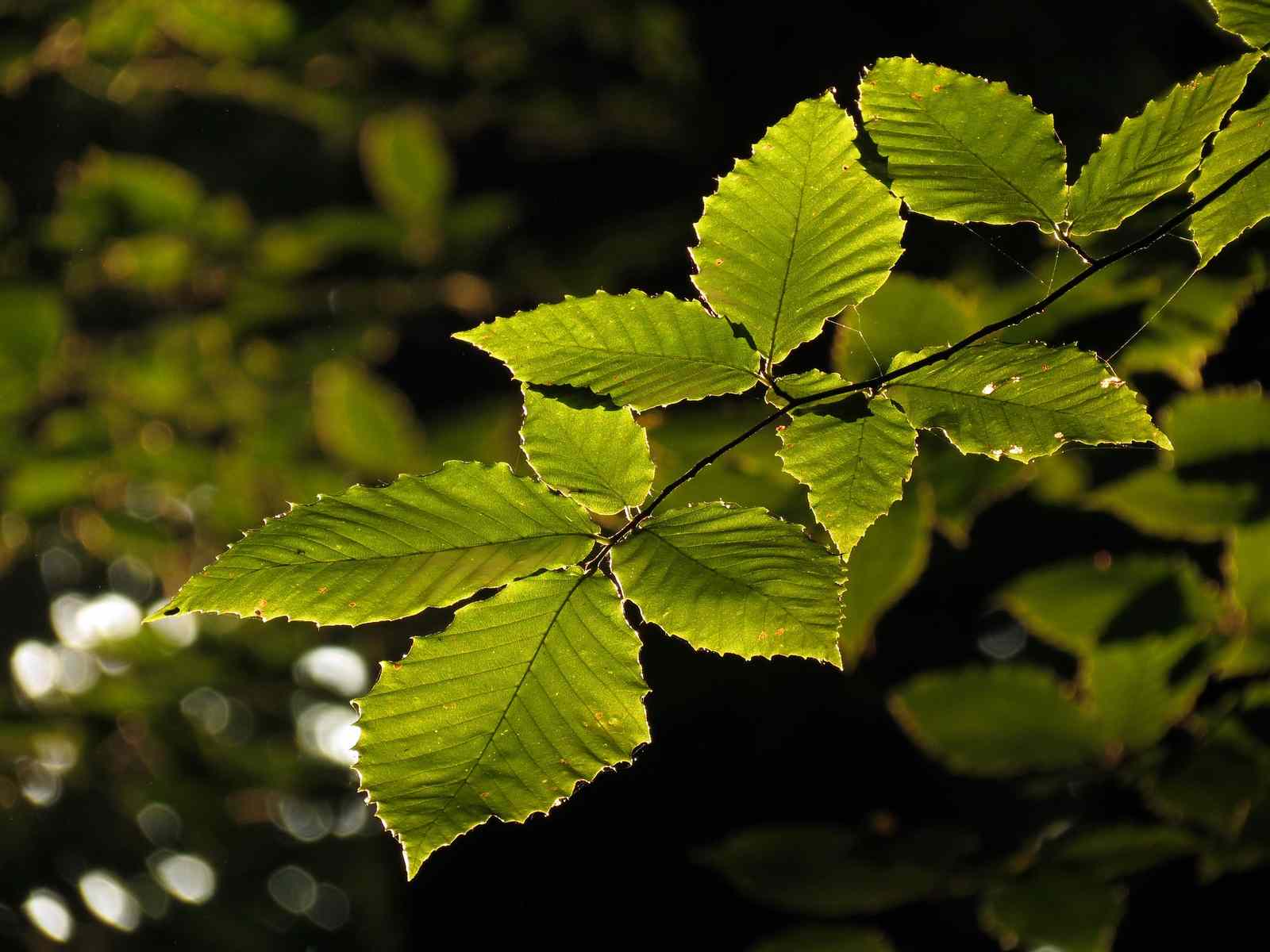
American Beech bark: smooth and light bluish-grey, occasionally with horizontal scar-like lines
About American Beech:
- Many different birds and animals (and sometimes even people) enjoy eating American Beech nuts.
- American Beech trees are threatened by Beech bark disease, a problem caused by beech scale insects and canker fungi.
3
American Elm:

American Elm habitat: southern and central Ontario, as far west west as Kenora and as far north as Timmins
American Elm size: can grow from 12-35 meters tall, 20 meter spread
American Elm shape: branches spread in an arched, fountain or vase-like shape
American Elm leaves: dark green oval, tough and asymmetrical pointed leaves in alternate arrangements

American Elm bark: furrowed and gray
About American Elm:
- American Elms are threatened by Dutch Elm Disease, a fungal disease spread by bark beetle larvae that tunnel beneath the tree’s outer bark.
- Due to its nearly odourless wood, containers for food were often made out of American Elm.
4
American Mountain Ash (You might also see Showy Mountain Ash):

American Mountain Ash habitat: south of Hudson Bay across Ontario, near swamps and the edges of forests
American Mountain Ash size: 3-9 meters tall, 3-5 meter spread
American Mountain Ash shape: rounded foliage
American Mountain Ash leaves: alternate, lance-oblong, dark green leaves, white flowers in the spring, and red or orange berry-like clusters of fruit in the summer
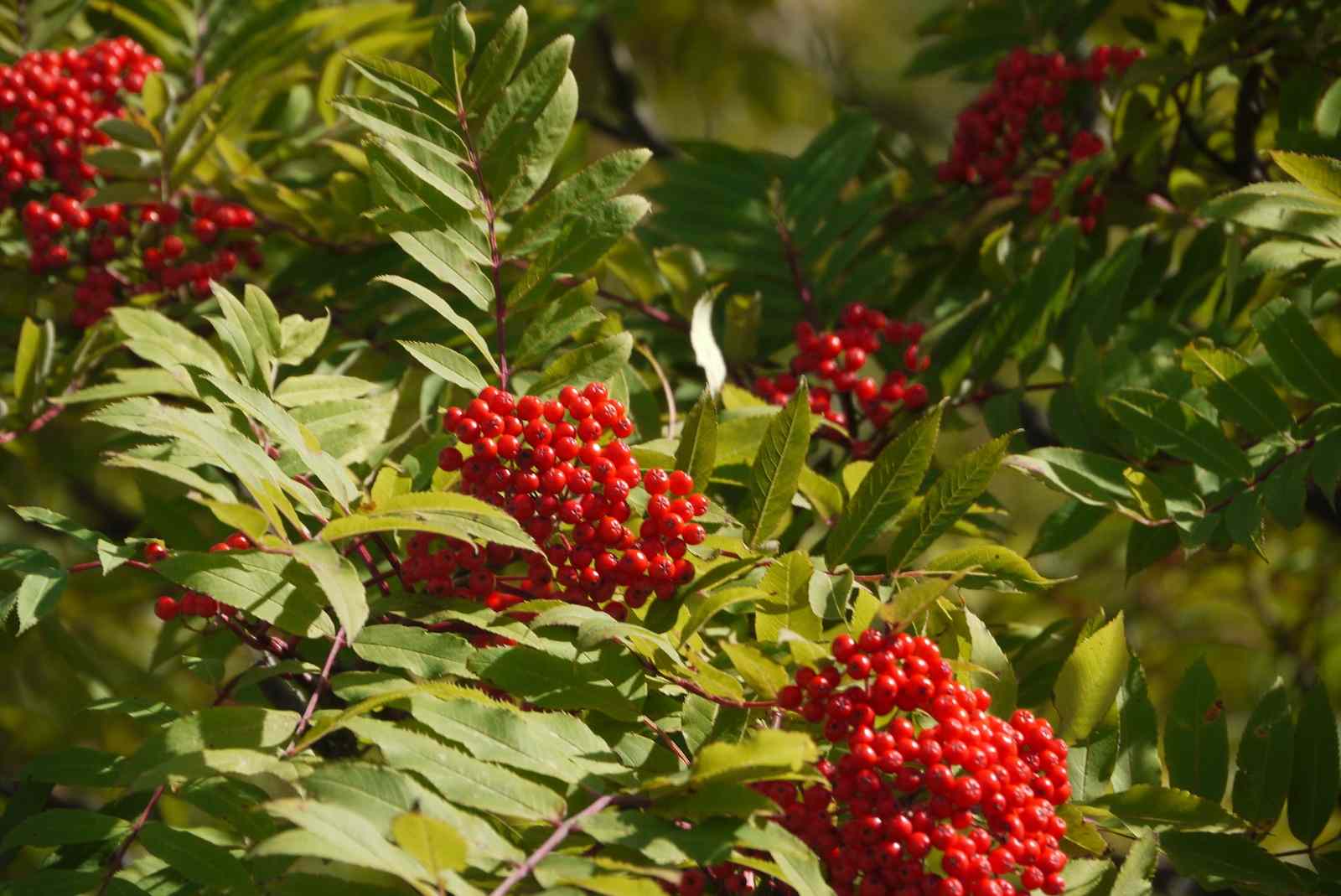
American Mountain Ash bark: grey, smoothish bark with small horizontal linear markings
About American Mountain Ash:
- Wildlife, such as butterflies, birds, bees, and even moose, love American Mountain Ash for its fruit, bark, twigs, and leaves.
- During fall frosts, the fruit ferments and birds can get intoxicated after eating it.
5
Balsam Fir:

Balsam Fir habitat: all across Ontario, but does especially well in cold climates
Balsam Fir size: 13-23 meters tall, 8-9 meter spread
Balsam Fir shape: tall and narrow, growing into a skinny, spire-like tip at its highest point
Balsam Fir needles: shiny dark green needles and barrel-shaped greyish brown cones
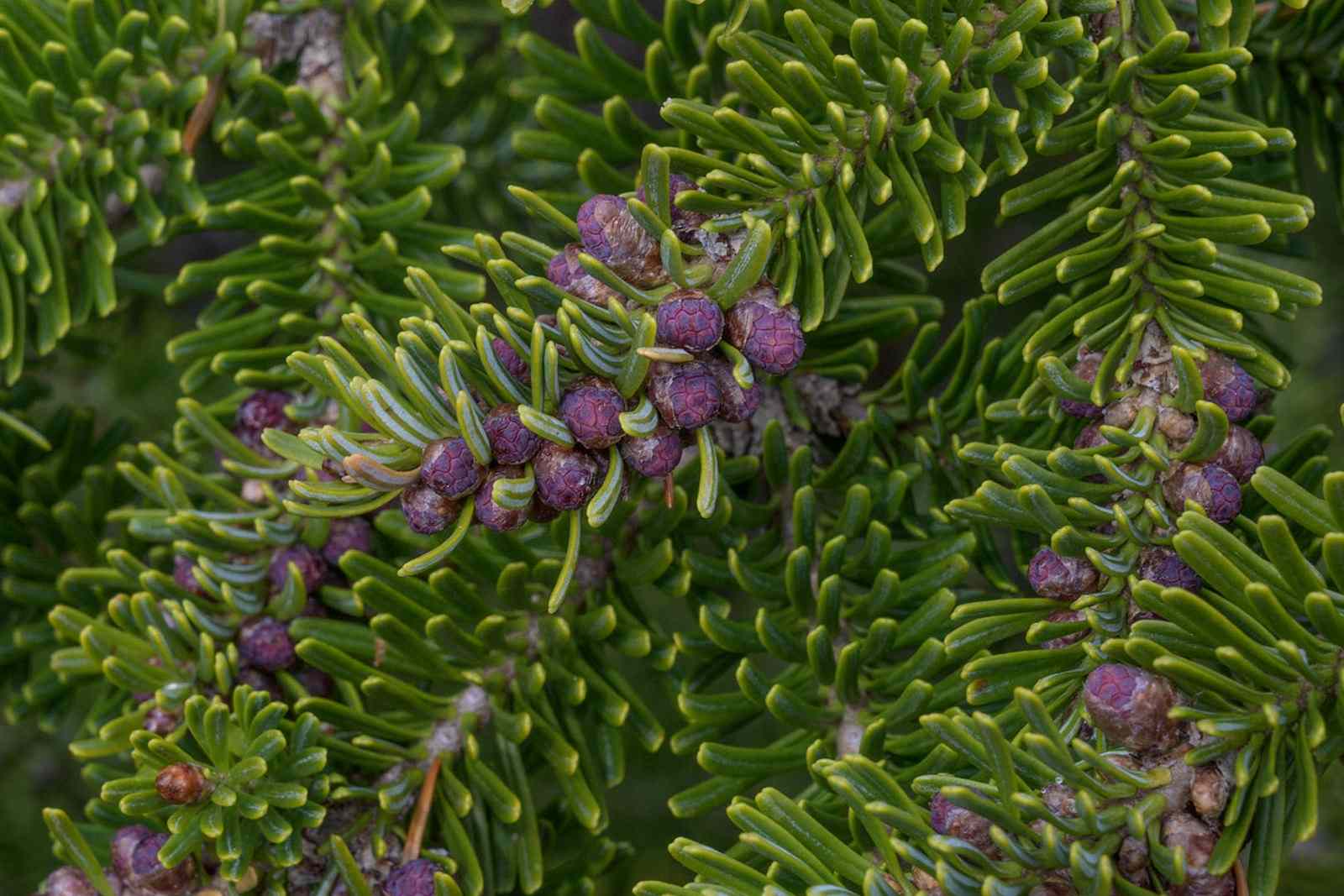
Balsam Fir bark: generally smooth and grey but cracks slight in older trees, marked by resin blisters
About Balsam Fir:
- Balsar Firs are often used as Christmas trees or wreathes.
- Balsam Firs can blow away in strong winds because their roots don’t expand very far into the soil.
6
Balsam Poplar:
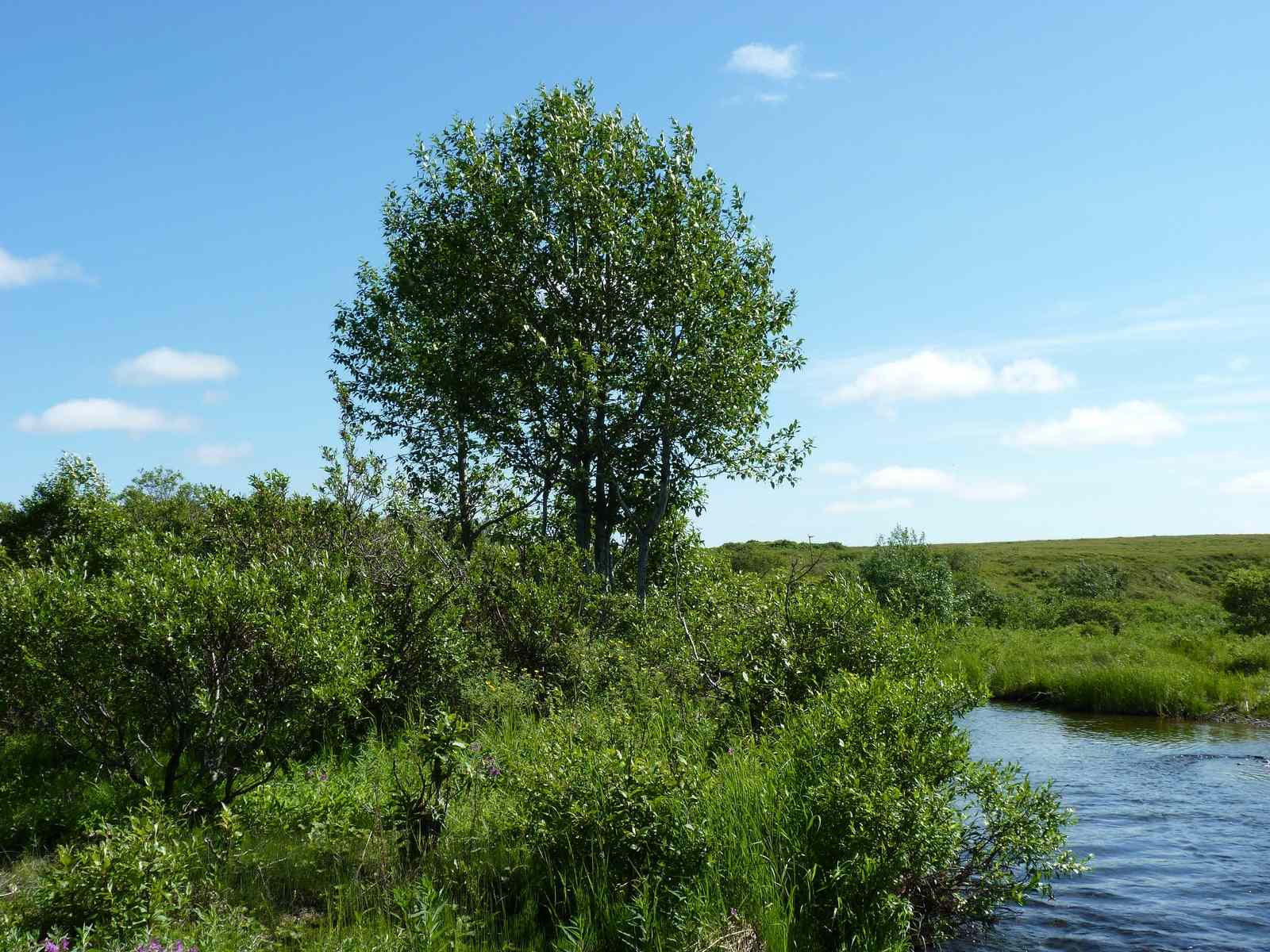
Balsam Poplar habitat: all across Canada and Ontario, except Hudson Bay’s northernmost outskirts
Balsam Poplar size: 25 meters tall, 15 meter spread
Balsam Poplar shape: tall and somewhat slender with a thin trunk
Balsam Poplar leaves: shiny and pointed alternate oval-shaped leaves with underside dotted by resin

Balsam Poplar bark: grooved and grey
About Balsam Poplar:
- Bees can use the tree’s waxy resin to disinfect their hives and seal it off from other creatures.
- Balsam Poplar is one of Ontario’s hardiest deciduous hardwood trees.
7
Bitternut Hickory (You might also see Shagbark Hickory):
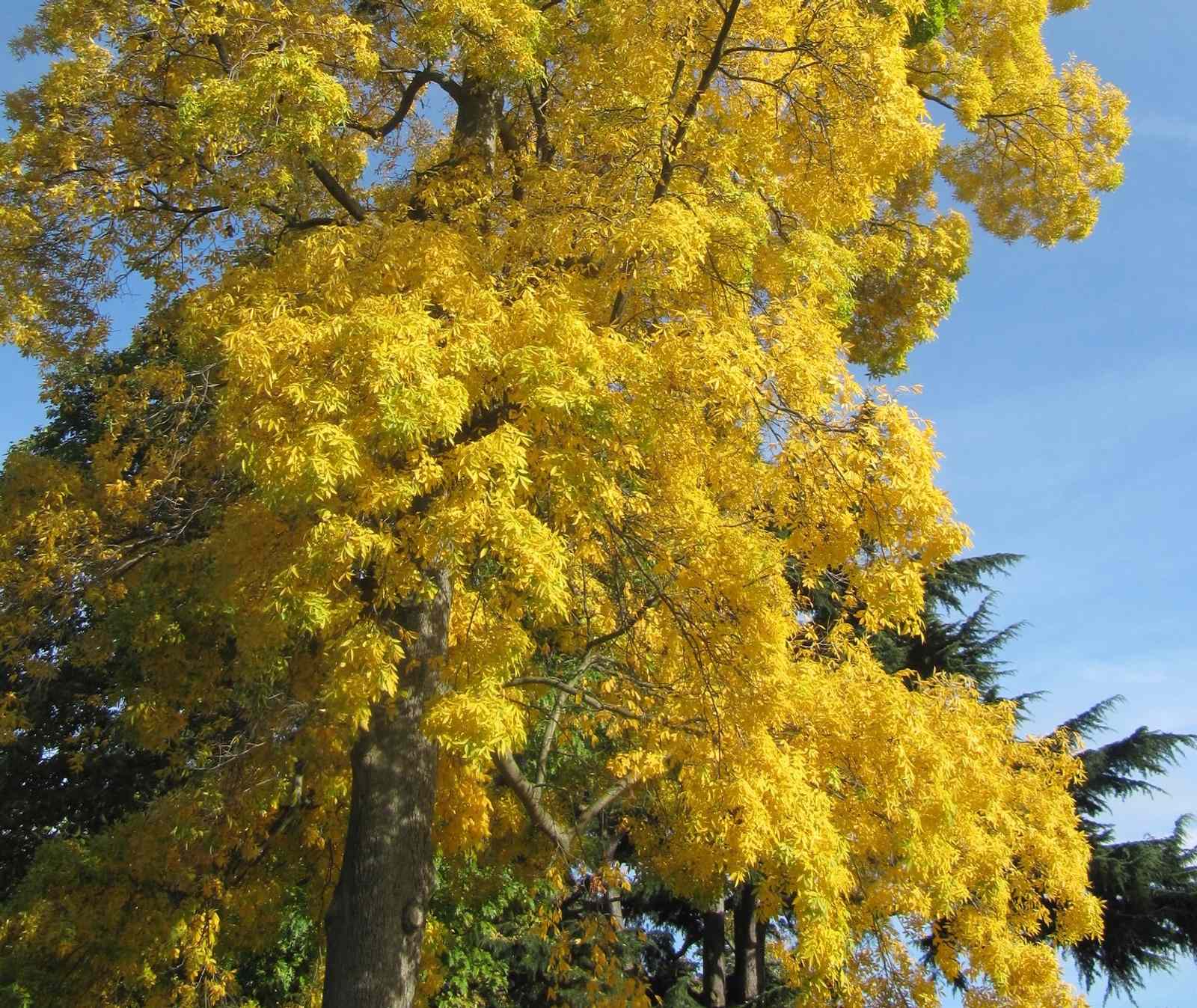
Bitternut Hickory habitat: southern Ontario
Bitternut Hickory size: 15 to 20 metres tall, 12-15 meter spread
Bitternut Hickory shape: tall and oval-shaped
Bitternut Hickory leaves: alternate, light green, lance-shaped leaves
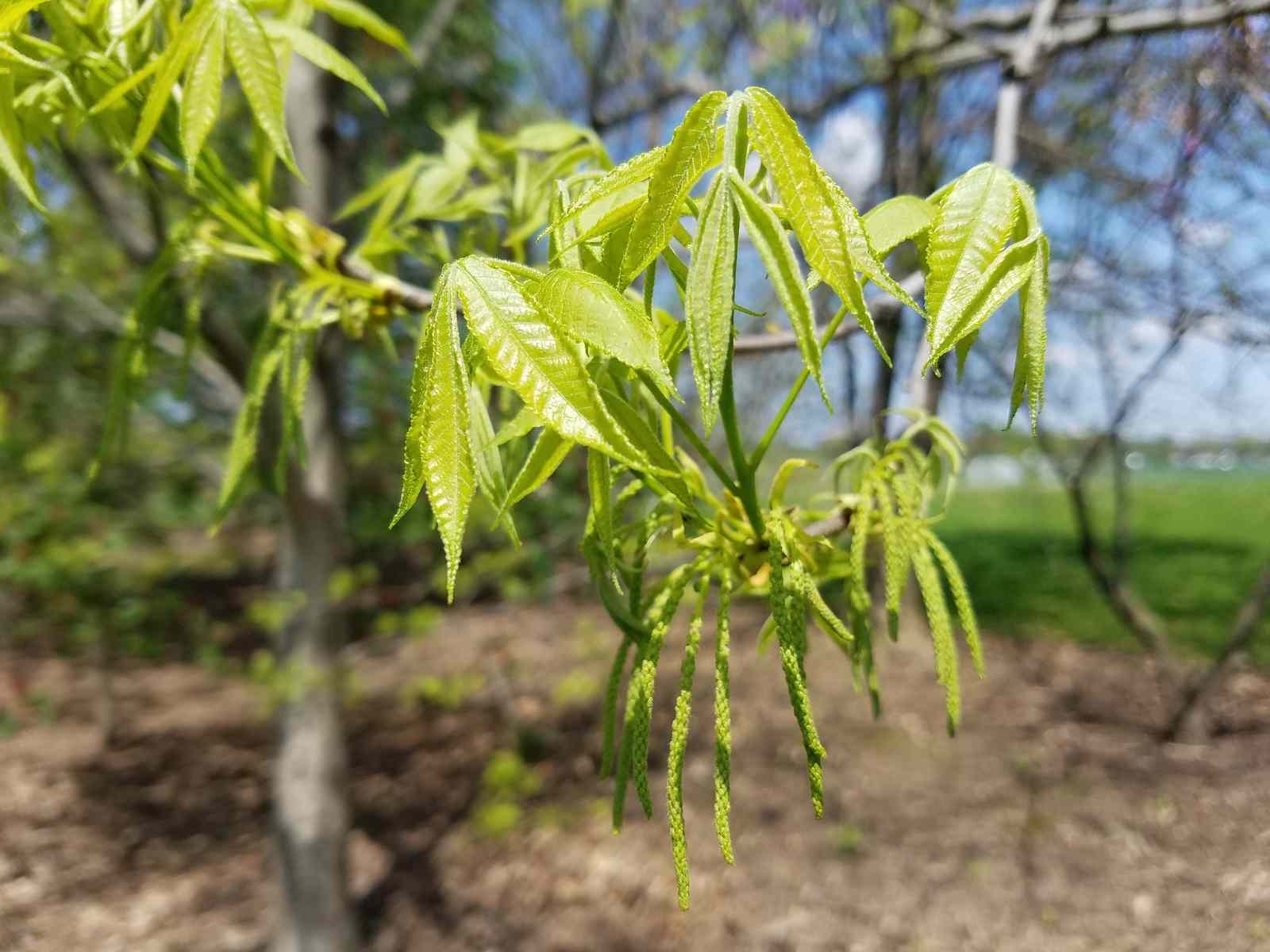
Bitternut Hickory bark: gray-green bark with narrow grooves
About Bitternut Hickory:
- This tree’s strong wood is used to make tool handles and sports equipment.
- Bitternut Hickory can be easily identified by its bright sulfur-coloured buds.
8
Black Walnut:

Black Walnut habitat: southwestern Ontario’s moist bottomlands
Black Walnut size: about 30 meters tall, 30 meter spread
Black Walnut shape: low branches and an open crown that gives a round shape that grows almost as wide as it is tall
Black Walnut leaves: oval-shaped single leaflets

Black Walnut bark: dark greyish brown furrowed bark
About Black Walnut:
- Black Walnut trees produce a compound called juglone that can injure or kill other plants.
- Indigenous people used Black Walnut for food, dyes, and medicine.
9
Black Willow:
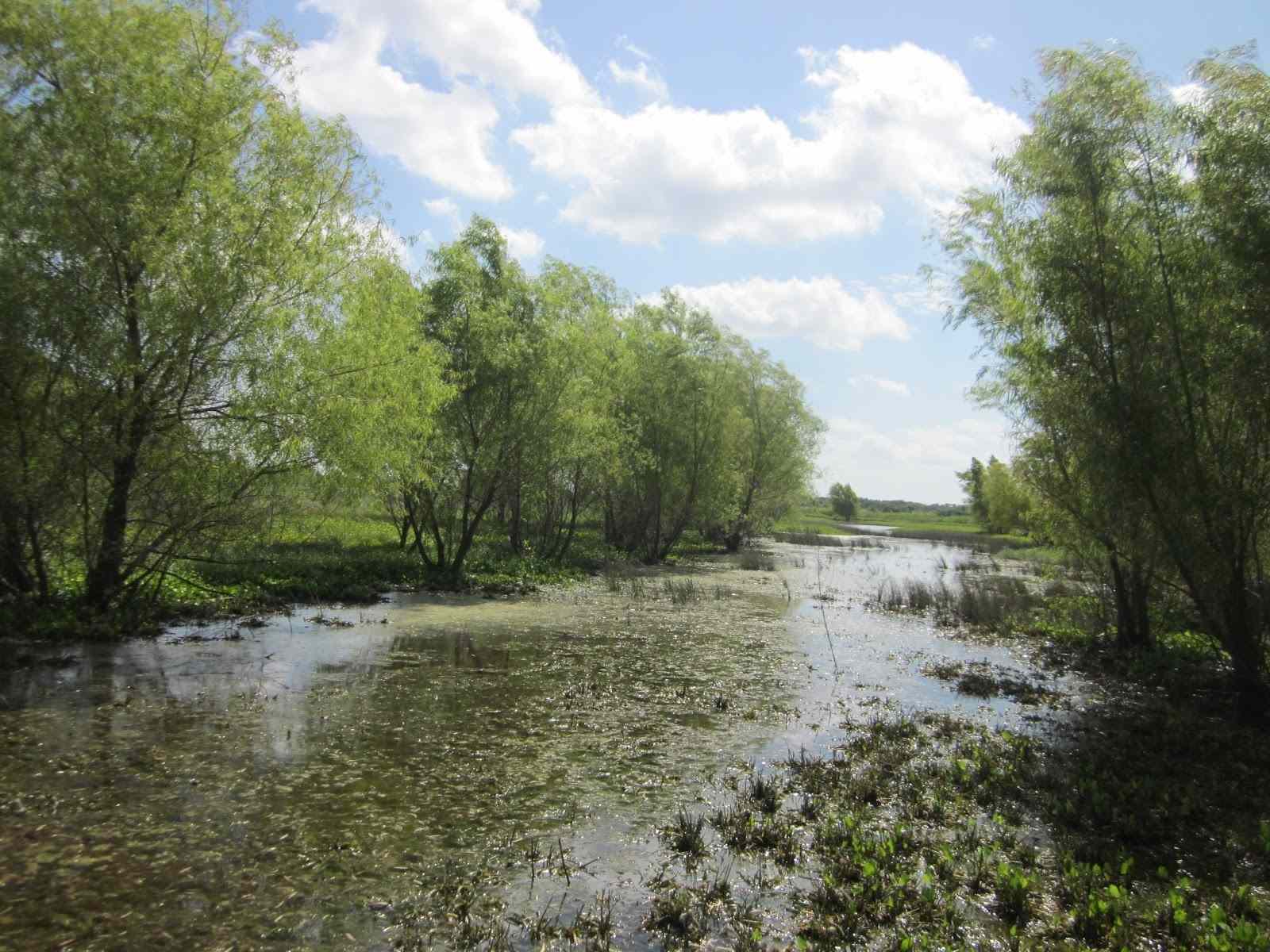
Black Willow habitat: across southern Ontario, growing west to the Bruce Peninsula and north to Pembroke
Black Willow size: 9-18 meters tall, 6-18 meter spread
Black Willow shape: irregular crown
Black Willow leaves: narrow, long, and pointed leaves

Black Willow bark: smooth dark brown bark becomes grooved with age
About Black Willow:
- Black Willow is the largest native willow in Ontario.
- Black willow grows quickly, as does it’s root system, making it a good tree to plant along waterways to control erosion.
10
Bur Oak (You might also see White Oak, Red Oak):
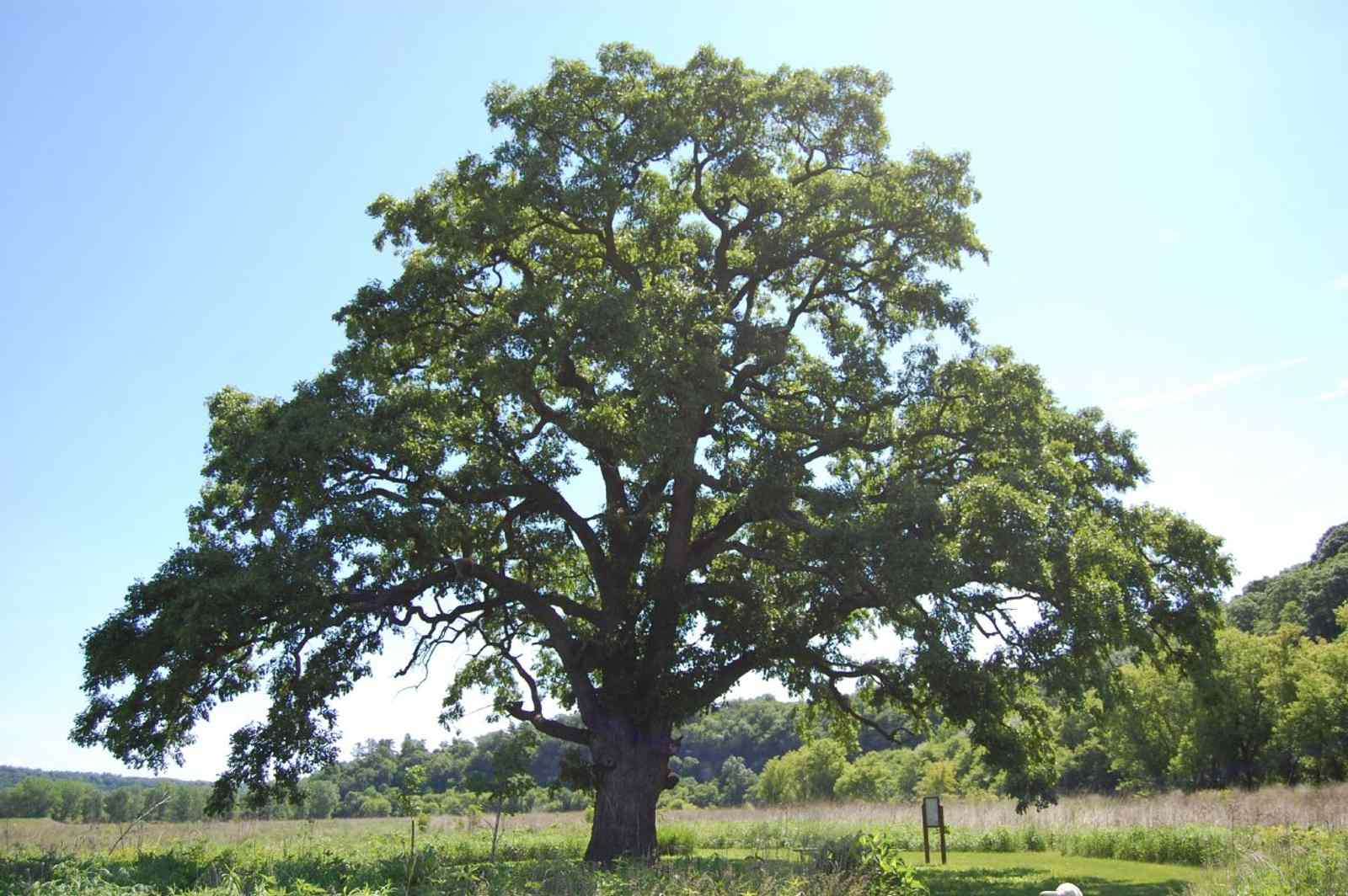
Bur Oak habitat: all across Ontario
Bur Oak size: 30 meters tall, 24 meter spread
Bur Oak shape: usually tall with a straight trunk, though in shallow soil it can grow to be gnarled
Bur Oak leaves: large shiny green leaves with lobes and variable shapes, brown acorns

Bur Oak bark: grey, rough, and scaly
About Bur Oak:
- Bur Oak is the most common oak tree in Ontario.
- Bur Oak’s bark is so thick it’s been known to survive forest fires.
11
Butternut:
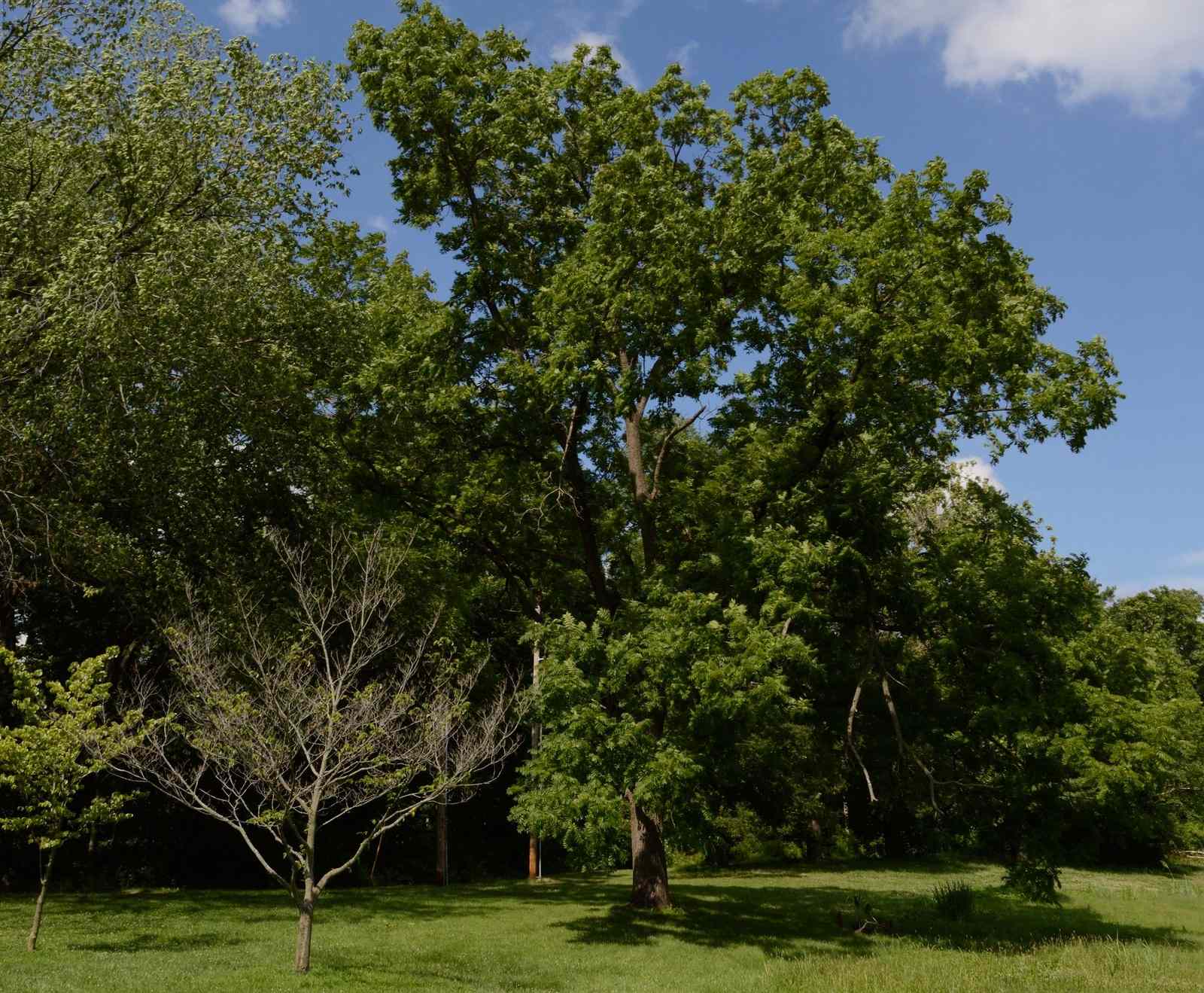
Butternut habitat: southwest Ontario, as far north as the Bruce Peninsula and south of the Canadian Shield
Butternut size: 30 meter tall, 9-15 meter spread
Butternut shape: wide foliage that branches out
Butternut leaves: alternate patterned, lance-shaped leaves that bear large, cylindrical nuts
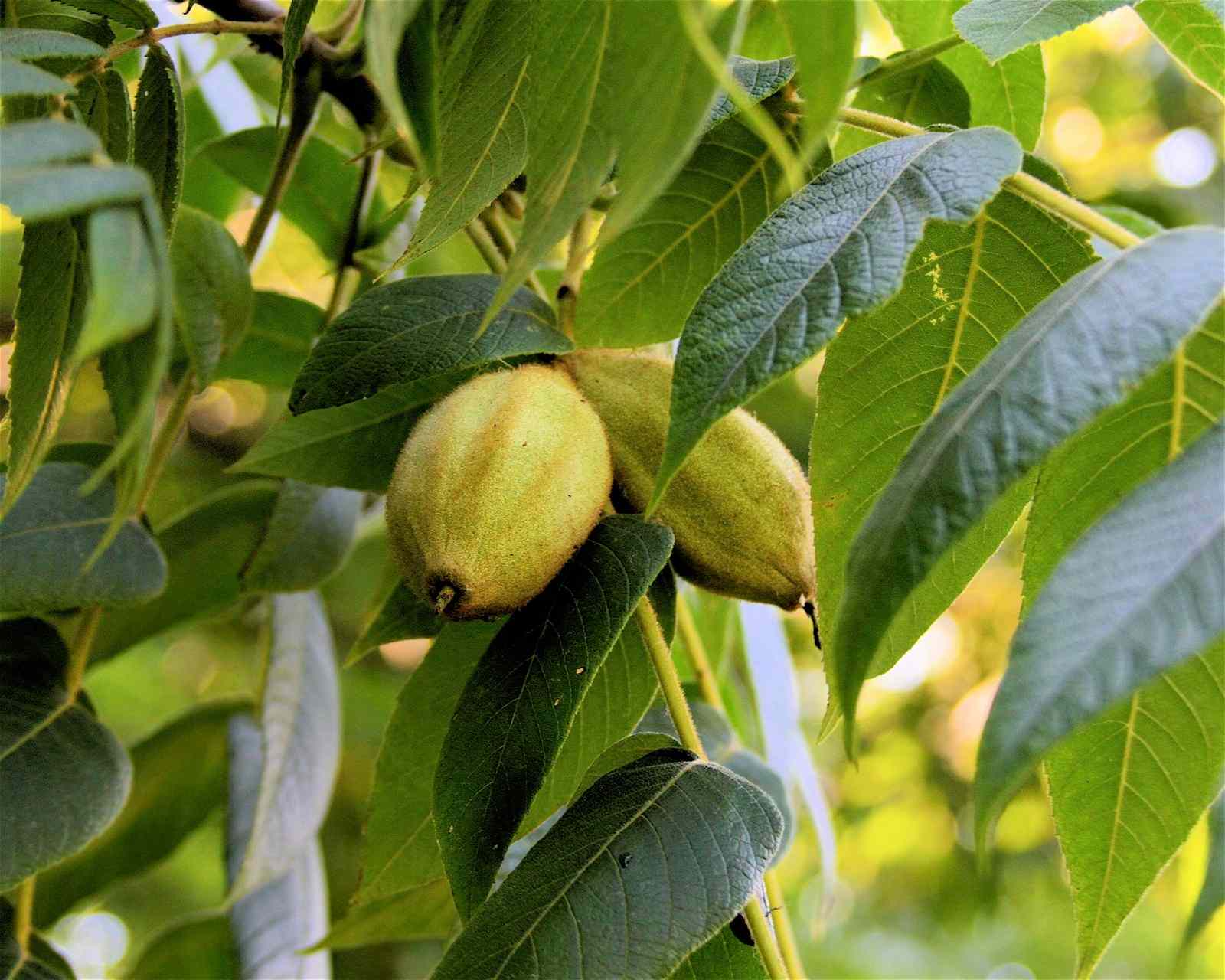
Butternut Bark: pale gray and rough
About Butternut:
- In the fall, Butternut produces edible nuts.
- Butternut is endangered in Ontario due to fungal disease.
If you see a Butternut tree, report the sighting.
12
Chokecherry:

Chokecherry habitat: southern and central Ontario
Chokecherry size: 9 meters tall, 3-6 meter spread
Chokecherry shape: oval or round, can be either a shrub or a small tree
Chokecherry leaves: broadly oval leaves with short tip and tiny teeth, when in flower, it has white elongated clusters of flowers with five petals

Chokecherry bark: dark grayish-brown and somewhat rough
About Chokecherry:
- Chokecherry berries and twigs provide important food for birds, deer, and other animals.
- Chokecherry trees are used to break wind on farms and around fields.
13
Eastern Hemlock:

Eastern Hemlock habitat: cool areas in southern Ontario
Eastern Hemlock size: 30 metres tall, 7-10 meter spread
Eastern Hemlock shape: conical
Eastern Hemlock needles: shiny green needles with pale undersides, brown oval-shaped pine cones
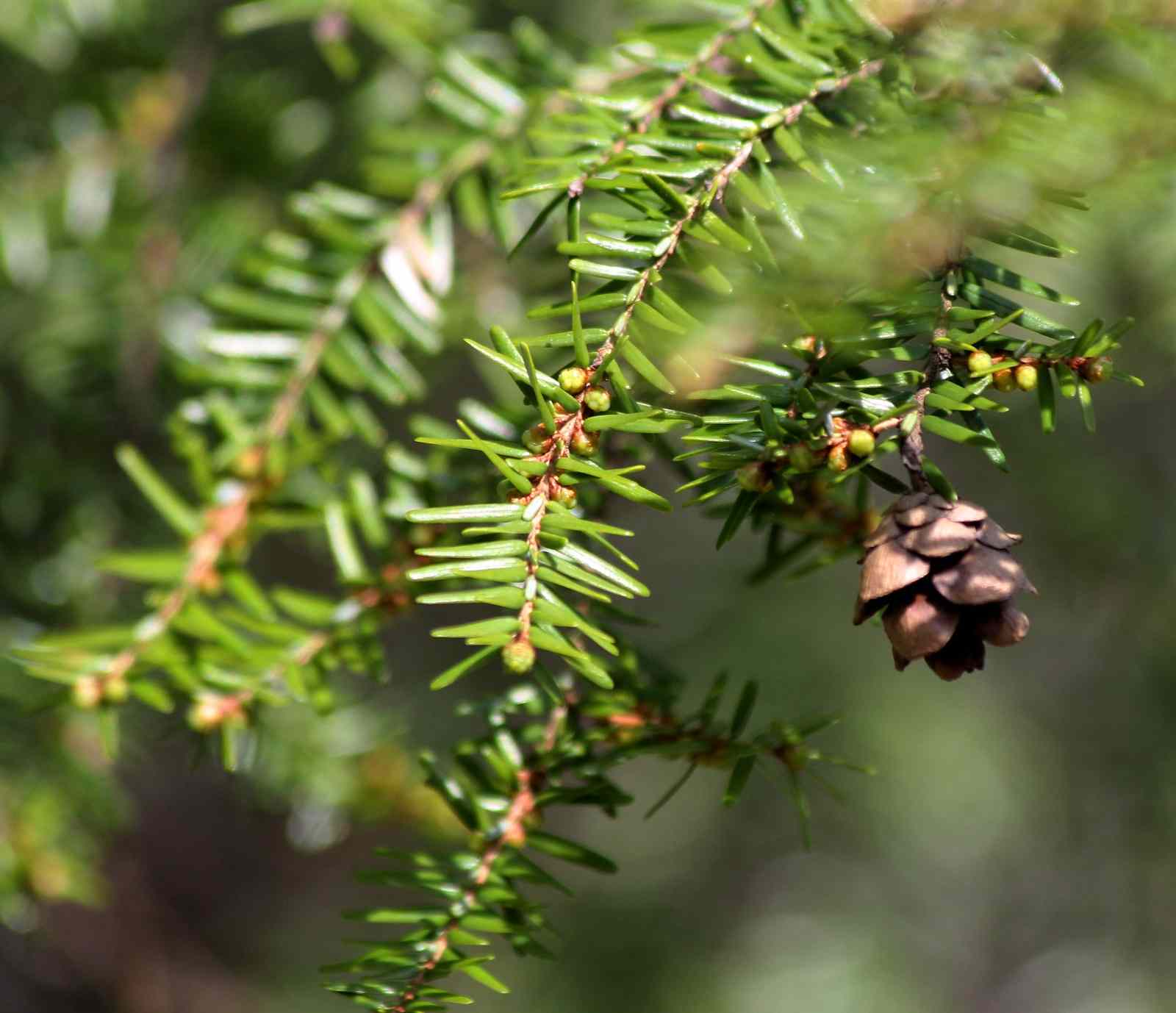
Eastern Hemlock bark: greyish brown with deep cracks
About Eastern Hemlock:
- Eastern Hemlock can grow to be as old as 600 years.
- The name "hemlock" is a reference to how the tree’s foliage smells similar to the poisonous herb hemlock when crushed.
14
Eastern White Cedar:

Eastern White Cedar habitat: across Ontario, especially near swamps, streams, and on limestone rocks
Eastern White Cedar size: 12-15 meter tall, 6 meter spread
Eastern White Cedar shape: conical shape with densely layered, arching branches
Eastern White Cedar leaves: scale-like yellowish-green leaves fan out from branches, cinnamon-brown cones grow in clumps of 5-6

Eastern White Cedar bark: rough and reddish-brown
About Eastern White Cedar:
- Indigenous people taught Jacques Cartier how to boil the tree’s leaves to get vitamin C for treating scurvy.
- White-tailed deer use the tree for shelter in the winter.
15
Jack Pine (You might also see Eastern White Pine, Red Pine):

Jack Pine habitat: widespread across Ontario because it can grow almost anywhere
Jack Pine size: 17-20 meters tall, 6-9 meter spread
Jack Pine shape: irregular, spreading shape
Jack Pine needles: light yellowish-green needles grow in bunches of two
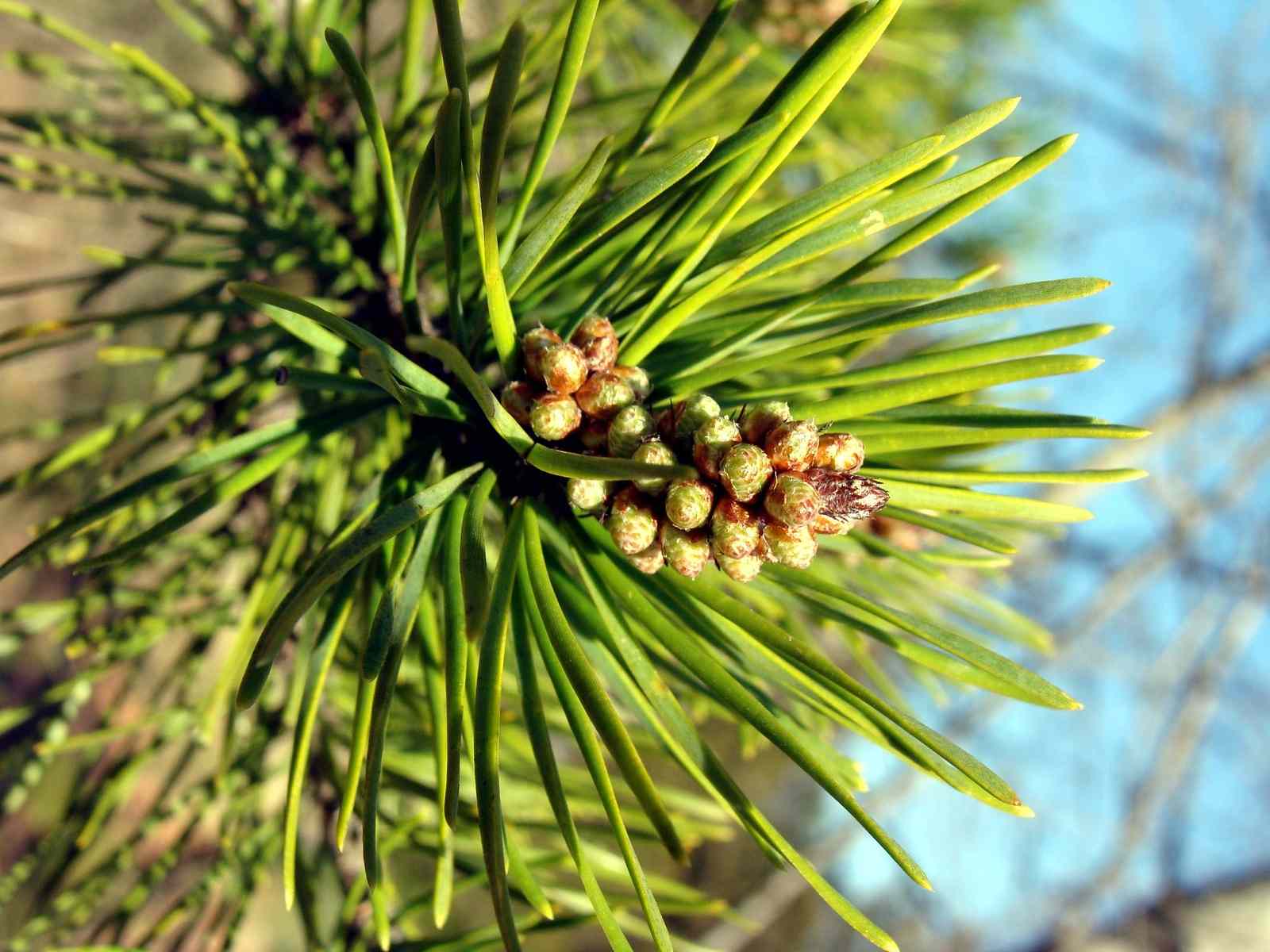
Jack Pine bark: scaley, reddish brown or grey
About Jack Pine:
- Canadian Group of Seven artist Tom Thomson famously captured the tree in his painting “The Jack Pine”.
- Jack Pine cones only open and release seeds on very hot days or during forest fires.
16
Red Mulberry:

Red Mulberry habitat: rare in Ontario, found in moist forests, wooded valleys, and floodplains on the western edges of Lake Ontario and Lake Erie as well as in the Niagara Region
Red Mulberry size: 6-10 meters tall
Red Mulberry shape: rounded foliage
Red Mulberry leaves: large, rough, and oval-shaped leaves and red or dark purple berries that look like stretched out blackberries

Red Mulberry bark: reddish-brown and flakey
About Red Mulberry:
- Red Mulberry is a species at risk in Ontario due to cross-breeding, disease, drought, and agriculture and urban development.
- Indigenous people used the fruit for beverages, preserves, breads, cakes, and more.
If you see a Red Mulberry tree, report the sighting.
17
Sassafras:
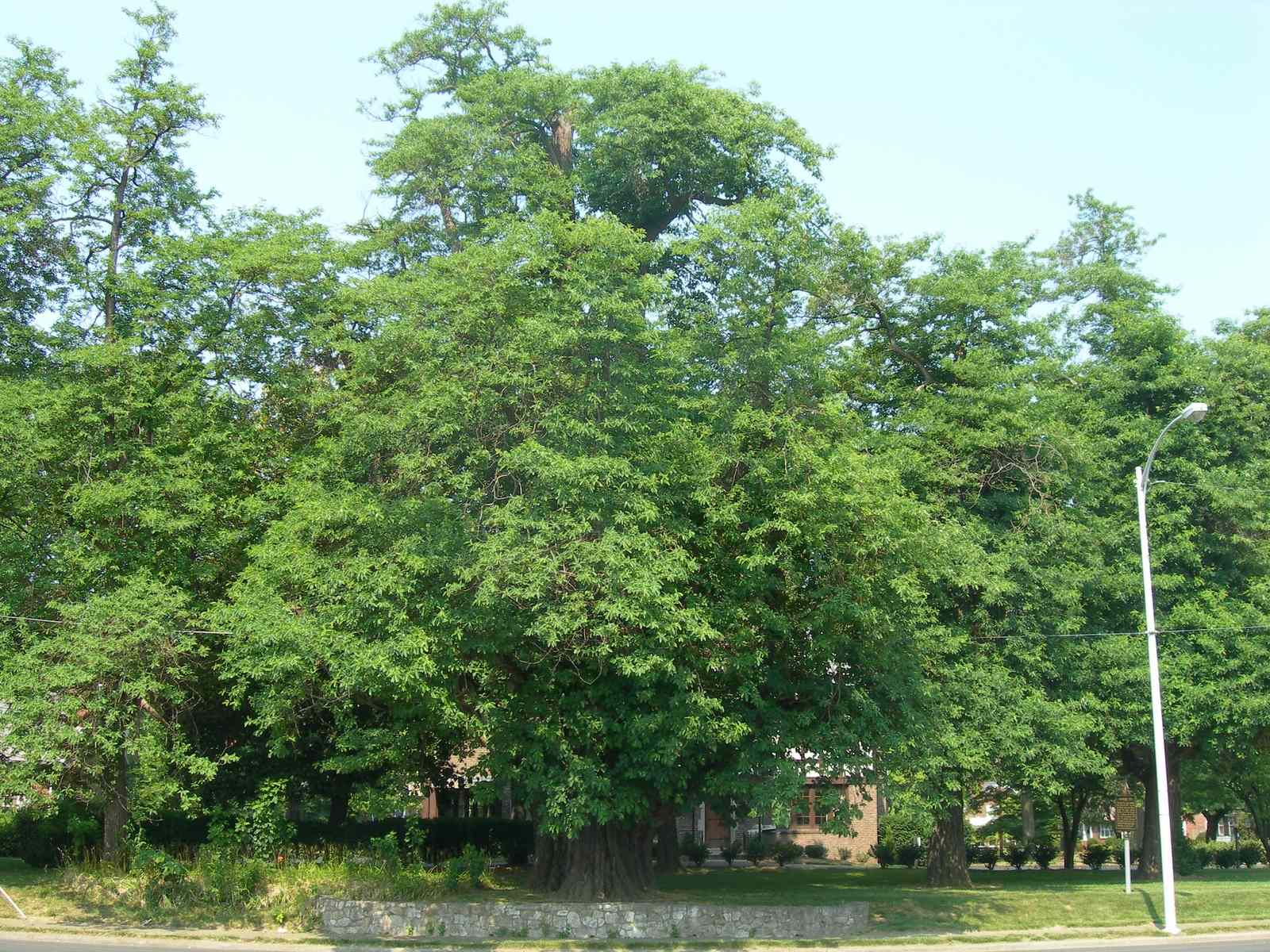
Sassafras habitat: spread out across southwestern Ontario, north to Toronto
Sassafras size: 20 meters tall, 7-12 meter spread
Sassafras shape: tall and bushy shrub or tree
Sassafras leaves: varied leaves, which can be oval-shaped, mitten-shaped, or three-lobed, small yellow flowers, and dark blue fruit

Sassafras bark: orange-brown and deeply grooved
About Sassafras:
- Sassafras leaves smell spicy, citrusy when bruised.
- Sassafras roots were an original ingredient in root beer.
18
Sugar Maple (You might also see Silver Maple, Red Maple):
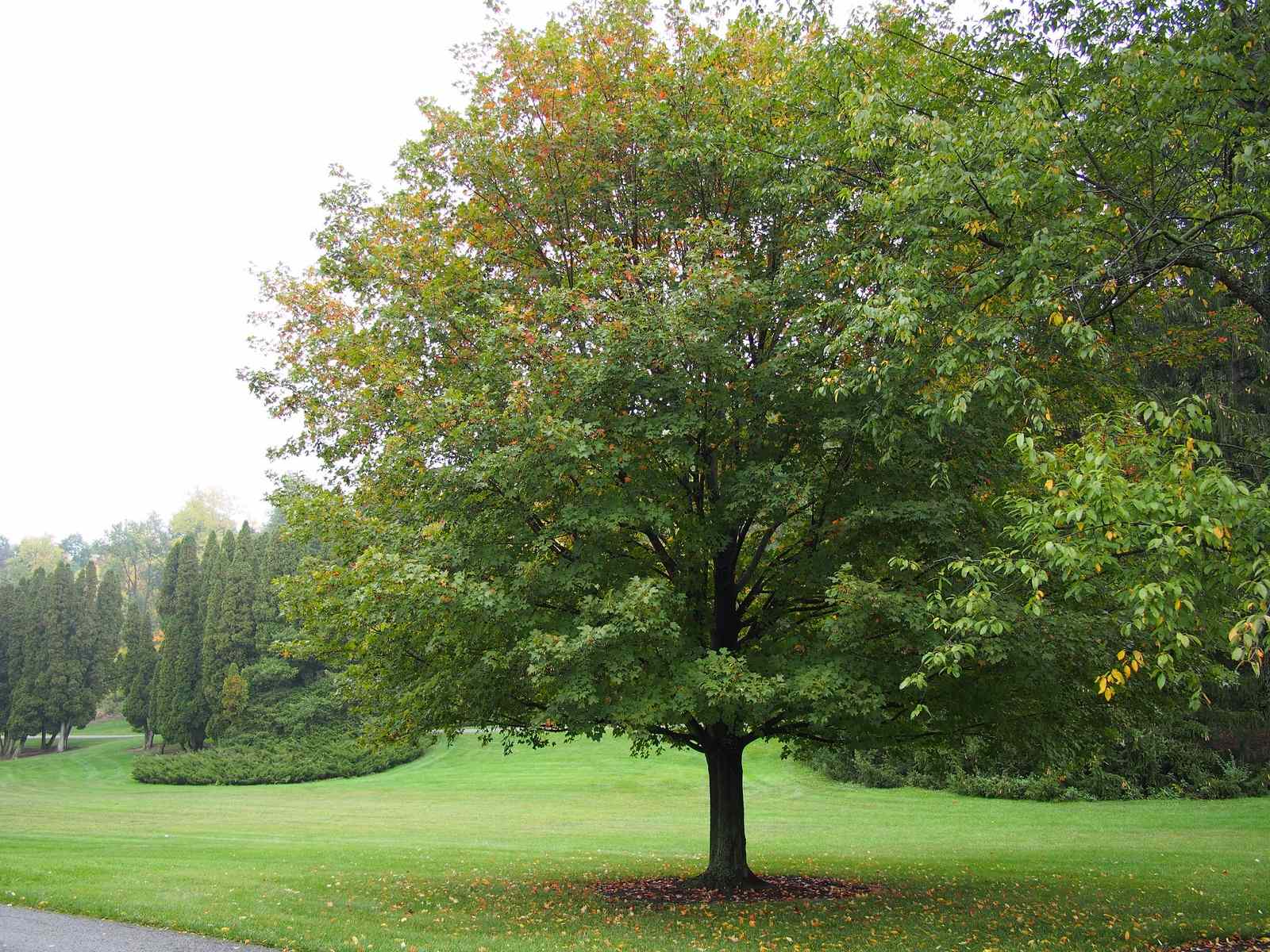
Sugar Maple habitat: southern and central Ontario
Sugar Maple size: 20-35 meter tall, 12-15 meter spread
Sugar Maple shape: round and full
Sugar Maple leaves: smooth and yellowish-green leaves with 3-5 pointed lobes

Sugar Maple bark: greyish and ridged
About Sugar Maple:
- The leaf on the Canadian flag is a Sugar Maple leaf, and Sugar Maple is Canada’s national tree.
- Sugar Maples produce the sap that’s made into maple syrup.
19
Sycamore:
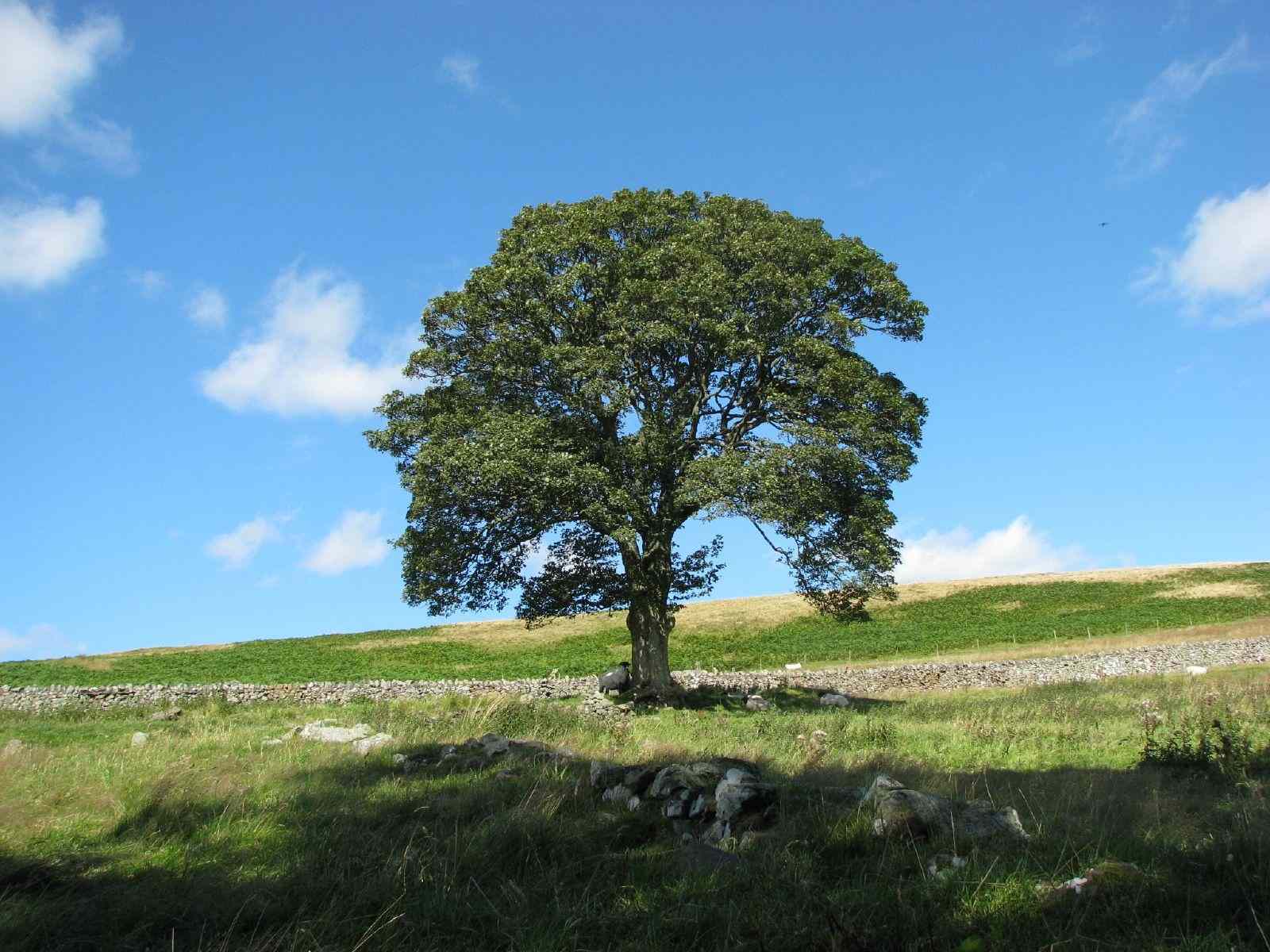
Sycamore habitat: primarily southwestern Ontario east to Toronto, but scattered north to Collingwood-Thornbury area and even Prince Edward Island
Sycamore size: 23-30 meters tall with about equal spread measurement
Sycamore shape: very tall with an upright trunk, crooked branches, and round foliage
Sycamore leaves: large and rough with 3-5 lobes and teeth
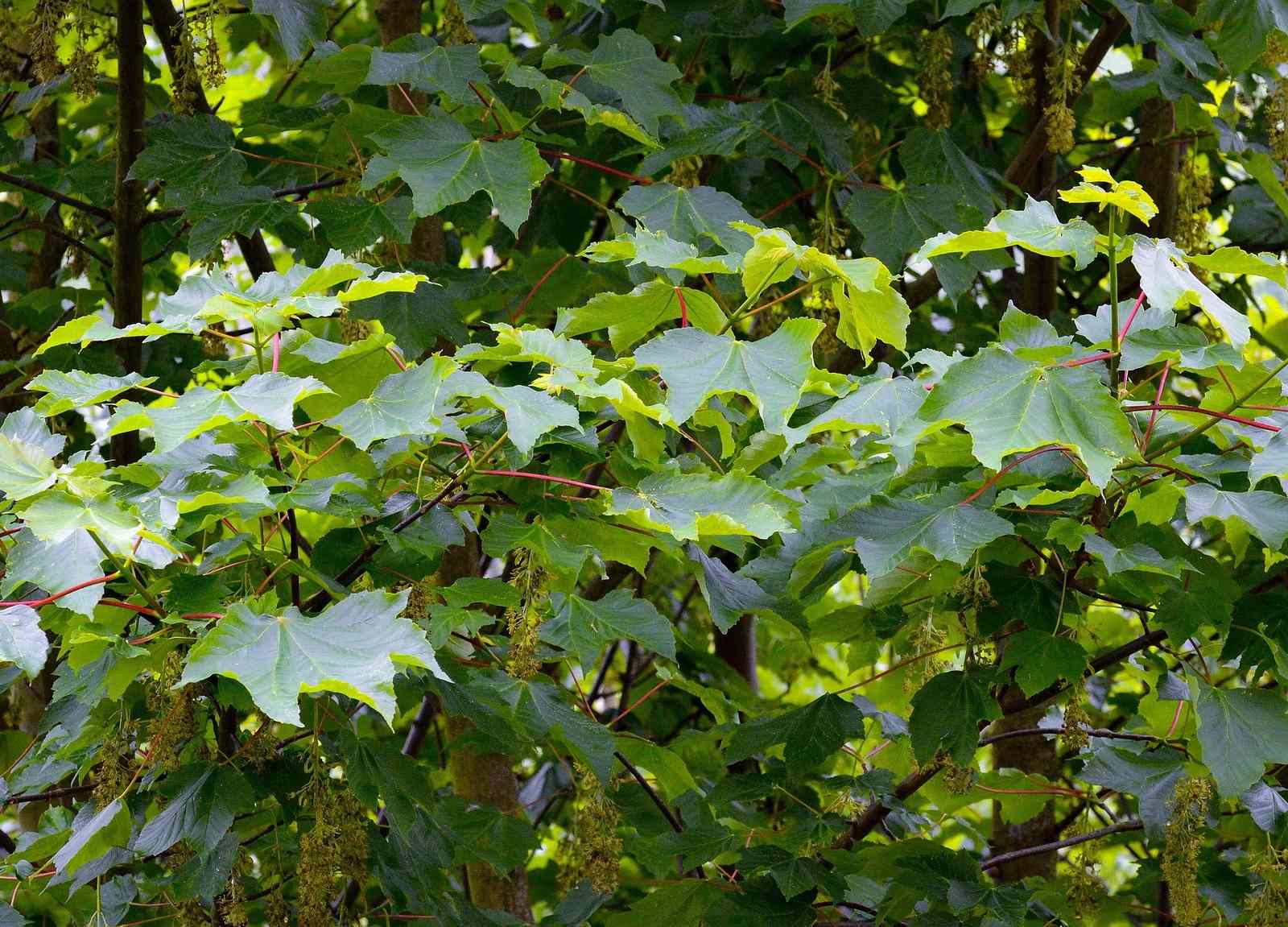
Sycamore bark: flakey grey outer bark with light white or tan inner bark
About Sycamore:
- Sycamore trees are one of eastern North America’s tallest and widest broadleaf trees.
- The largest Sycamore tree in Ontario was 263 cm at breast height.
20
Tamarack:
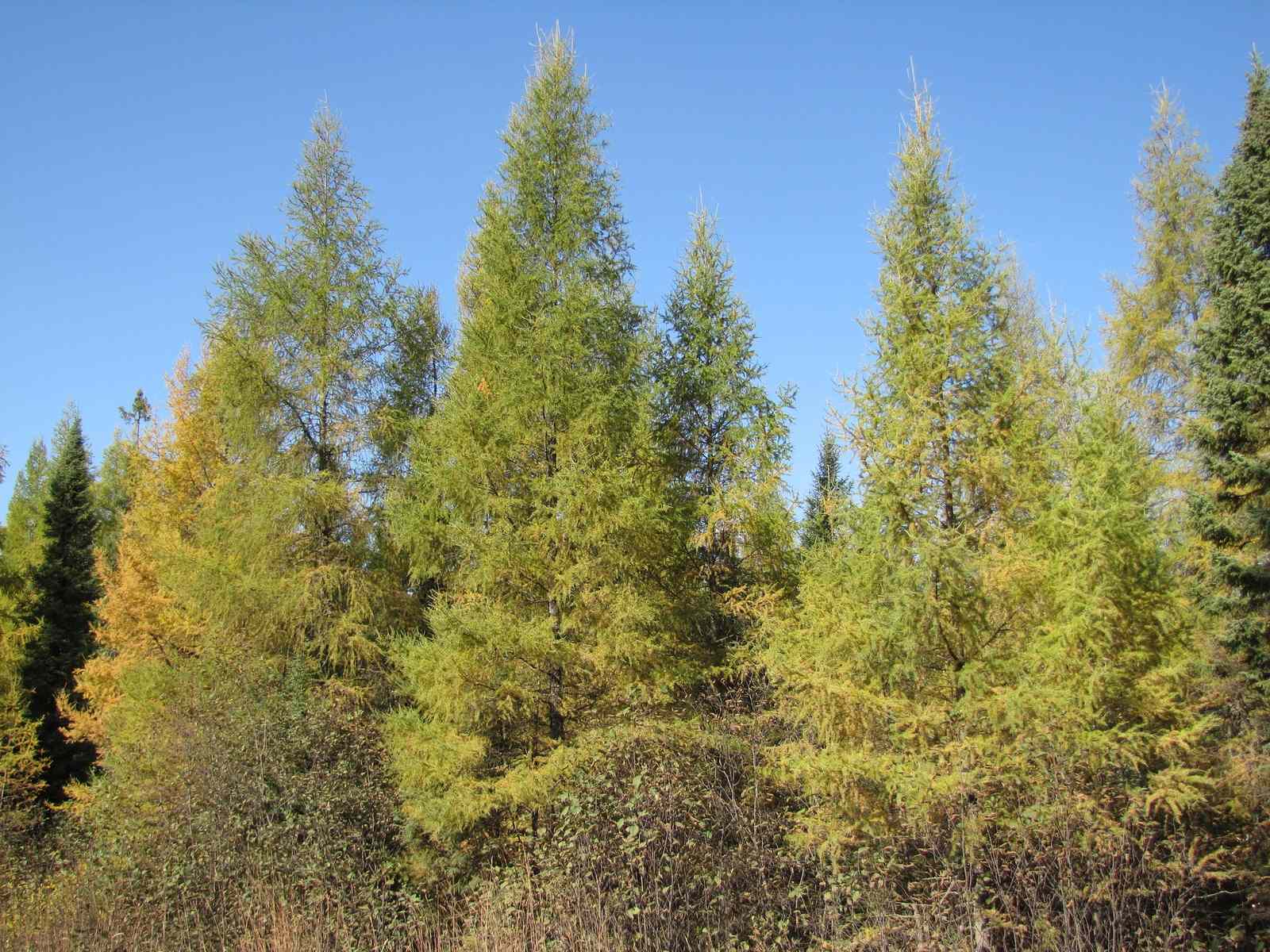
Tamarack habitat: all over Ontario with high concentrations in northern Ontario
Tamarack size: 15- 20 meters tall, 4-9 meter spread
Tamarack shape: conical with sparse, spread out branches
Tamarack needles: soft, pliable, green needles grow in tufts of 10 to 60, small light brown cones
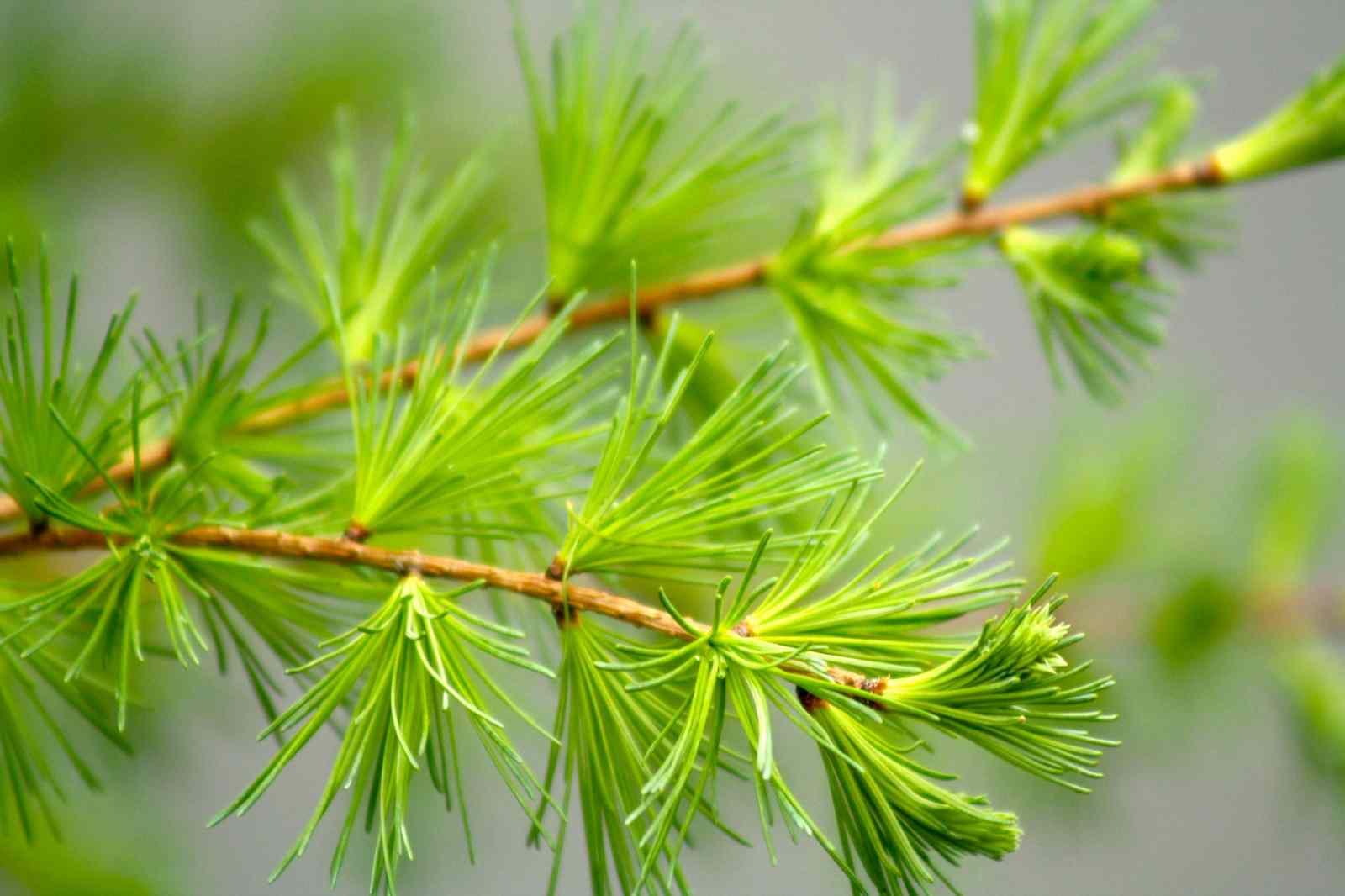
Tamarack bark: scaly and reddish-brown
About Tamarack:
- Unlike most conifers, Tamarack loses its needles in the autumn.
- Tamarack grows in every Canadian province and territory.
21
Trembling Aspen:
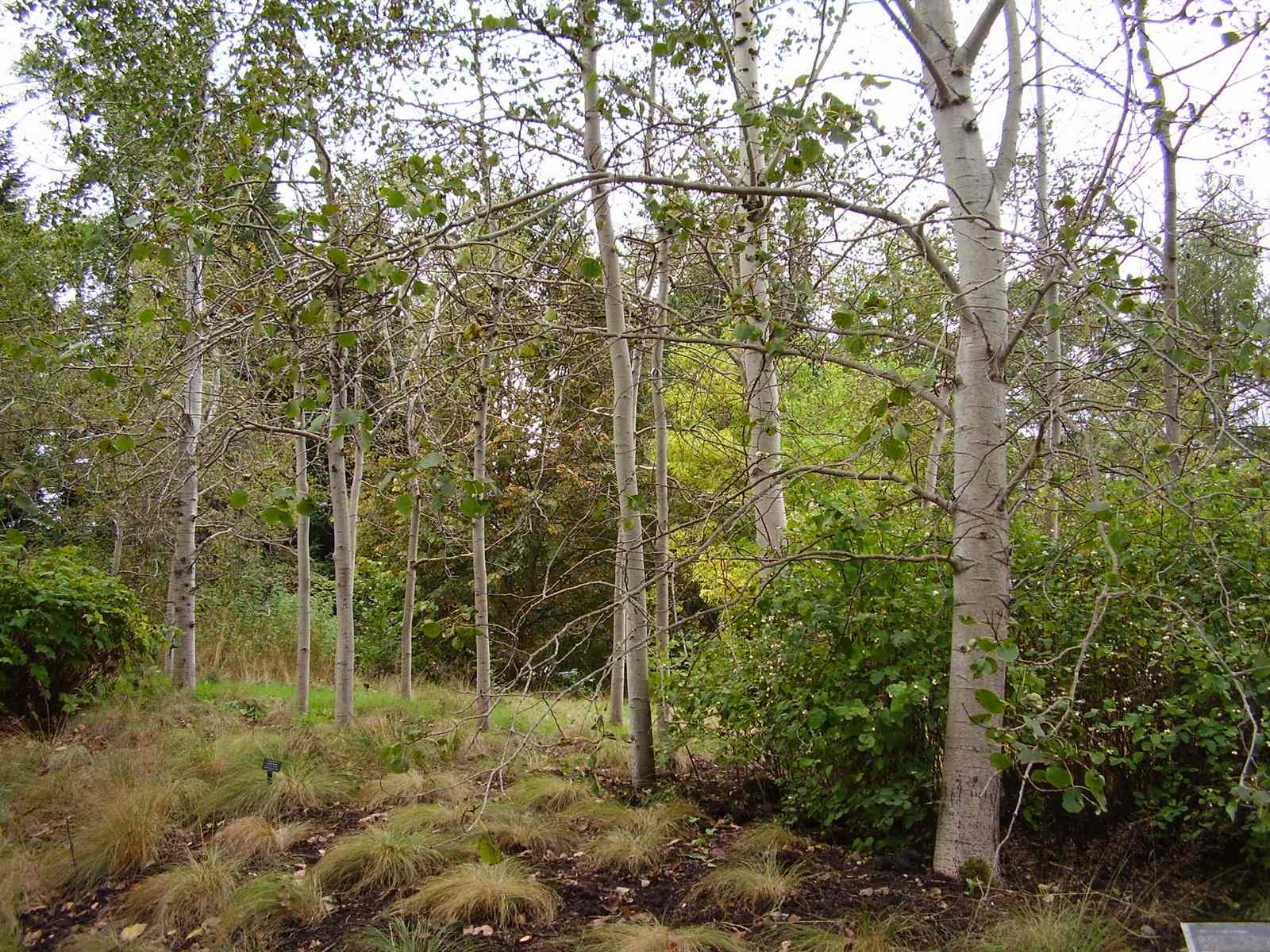
Trembling Aspen habitat: open areas throughout Ontario, except for Hudson Bay’s northernmost edge
Trembling Aspen size: 25 meters tall, 6-9 meter spread
Trembling Aspen shape: slender, straight trunk and narrow foliage
Trembling Aspen leaves: round or oval, growing into a sharp tip
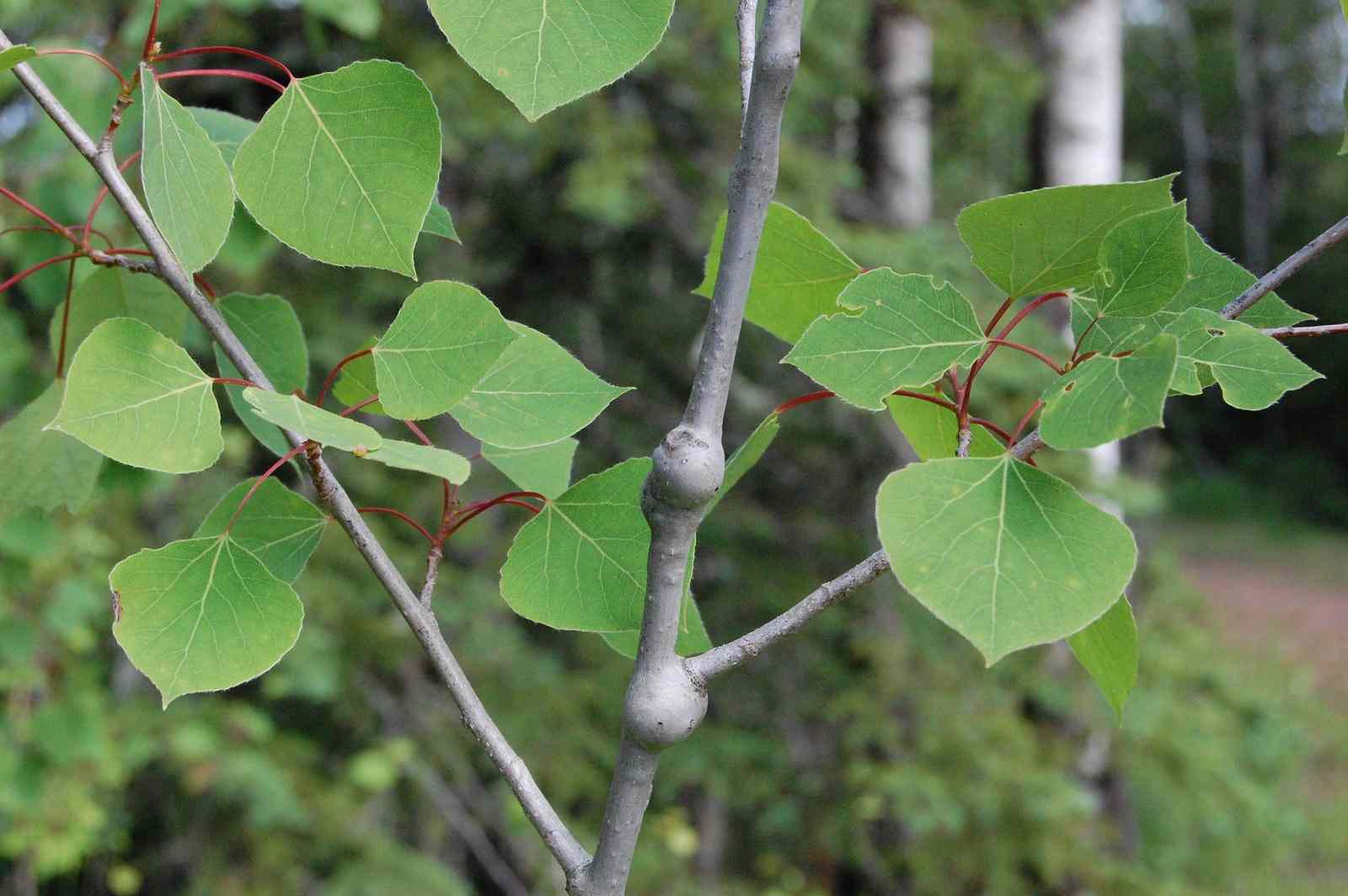
Trembling Aspen bark: smooth and light coloured, gets darker and rougher with age
About Trembling Aspen:
- Trembling Aspen gets its name from the way its leaves flutter in the wind.
- Trembling Aspen has the widest natural range of any North American tree.
22
White Ash:
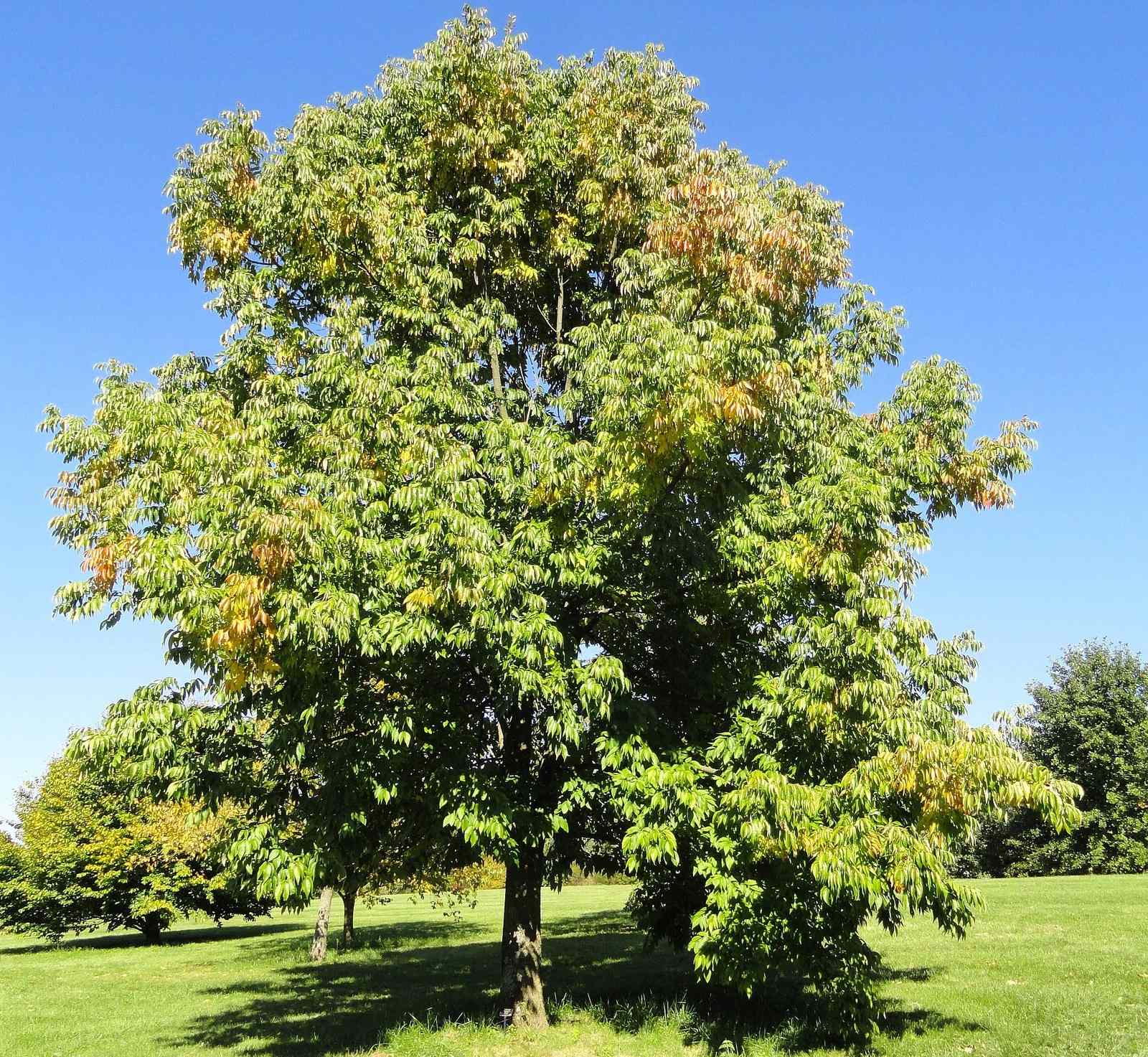
White Ash habitat: southern Ontario, as far north as Lake Nipissing and Sault Ste. Marie in deciduous forests
White Ash size: 15-30 meters tall, 12-15 meter spread
White Ash shape: round or oval foliage
White Ash leaves: branches have between 6 and 9 leaves that are dark green with pale undersides
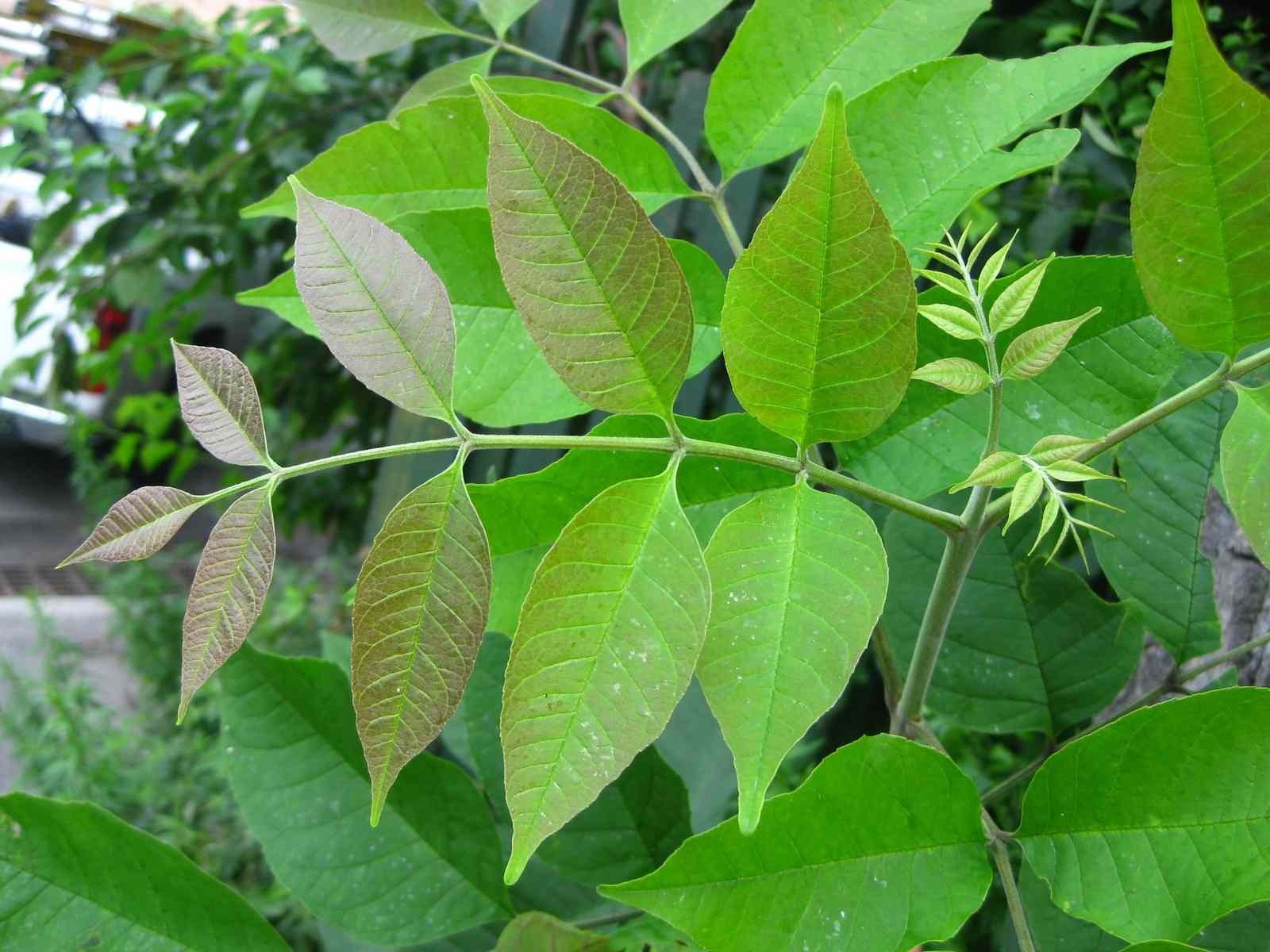
White Ash bark: pale grey and ridged
About White Ash:
- White Ash is the largest of Ontario’s native ash species.
- The name “White Ash” comes from the pale bark and undersides of the leaves.
23
White (or Paper) Birch (You might also see Gray Birch, Yellow Birch):
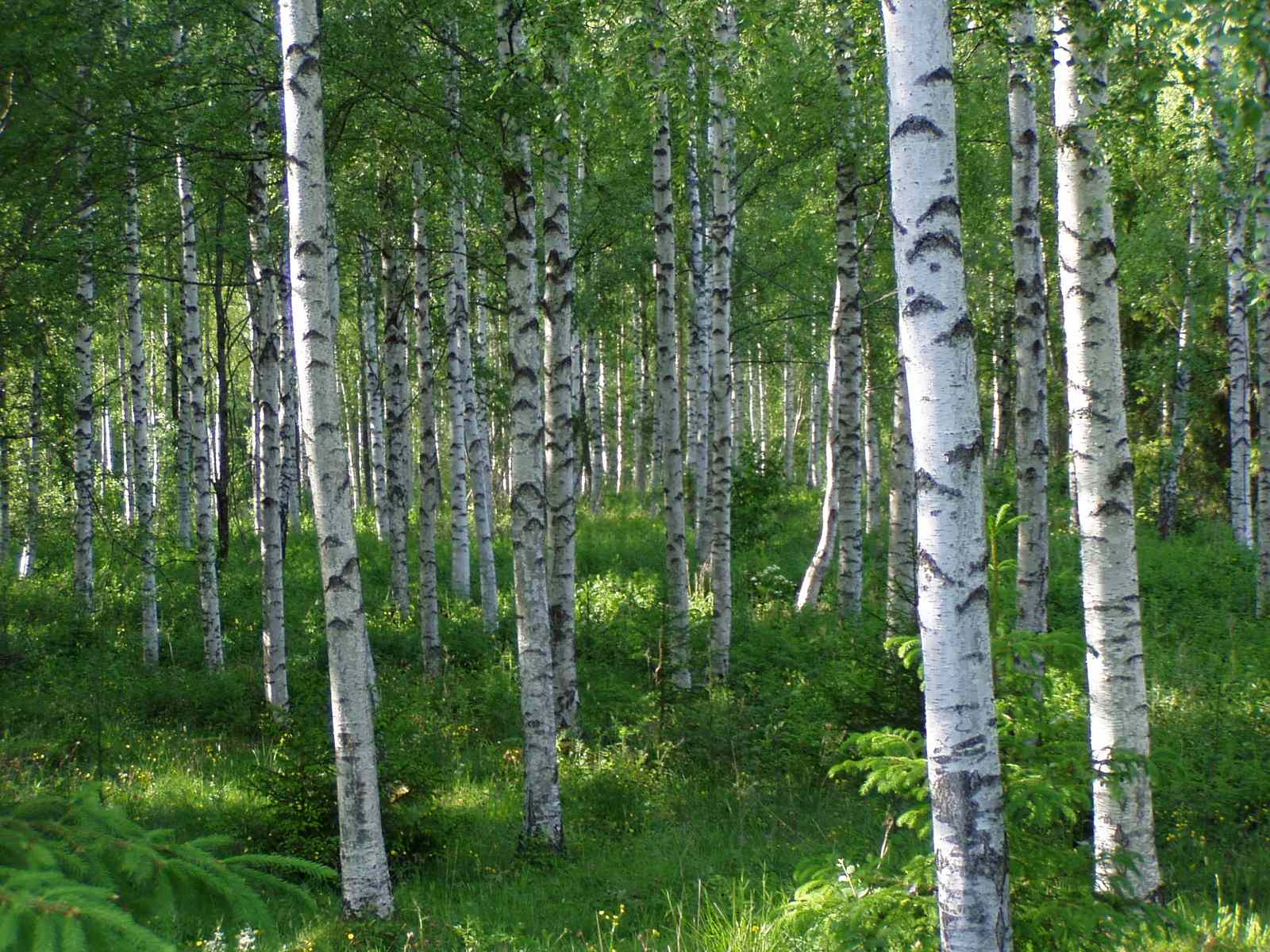
White Birch habitat: all across Ontario, except for Hudson Bay’s shores
White Birch size: 15-25 meters tall, 10-11 meter spread
White Birch shape: slim trunk with a narrow, oval or pyramid-shaped crown
White Birch leaves: triangle-shaped and fine hair underneath
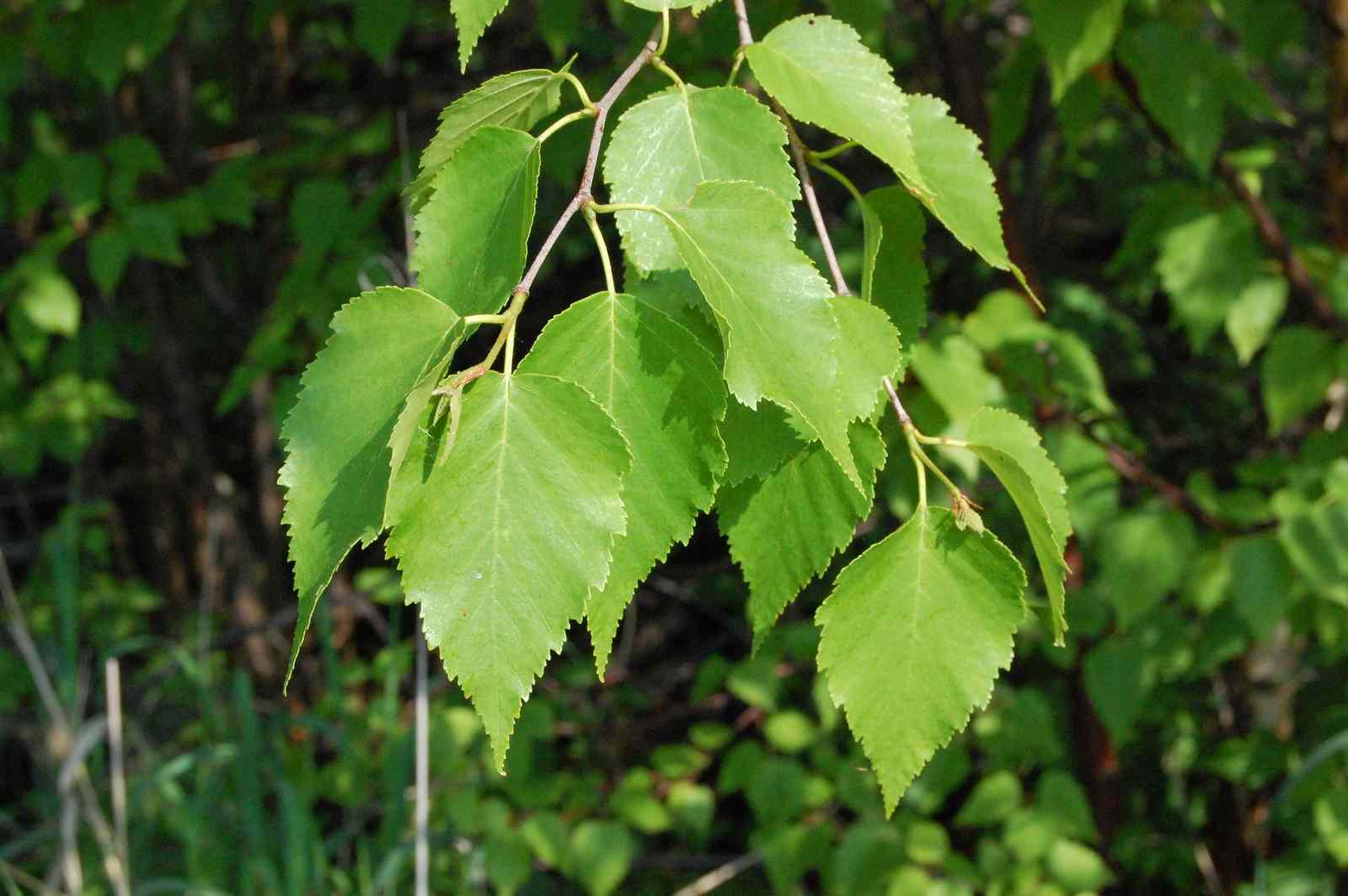
White Birch bark: smooth, peeling white bark
About White Birch:
- Indigenous people used White Birch bark to make canoes, baskets, and cradles.
- You can make White Birch syrup, but you’ll need about 100 litres of sap to make one litre of syrup.
24
White Spruce (You might also see Black Spruce):

White Spruce habitat: prefers cold temperatures, common in northern Ontario, but can be found in southern Ontario as well
White Spruce size: 24-30 metres tall, 3-6 meter spread
White Spruce shape: large a conical with a narrow crown
White Spruce needles: stiff, sharp, four-sided bluish-green needles that grow in a spiral pattern from twigs, light brown seed cones
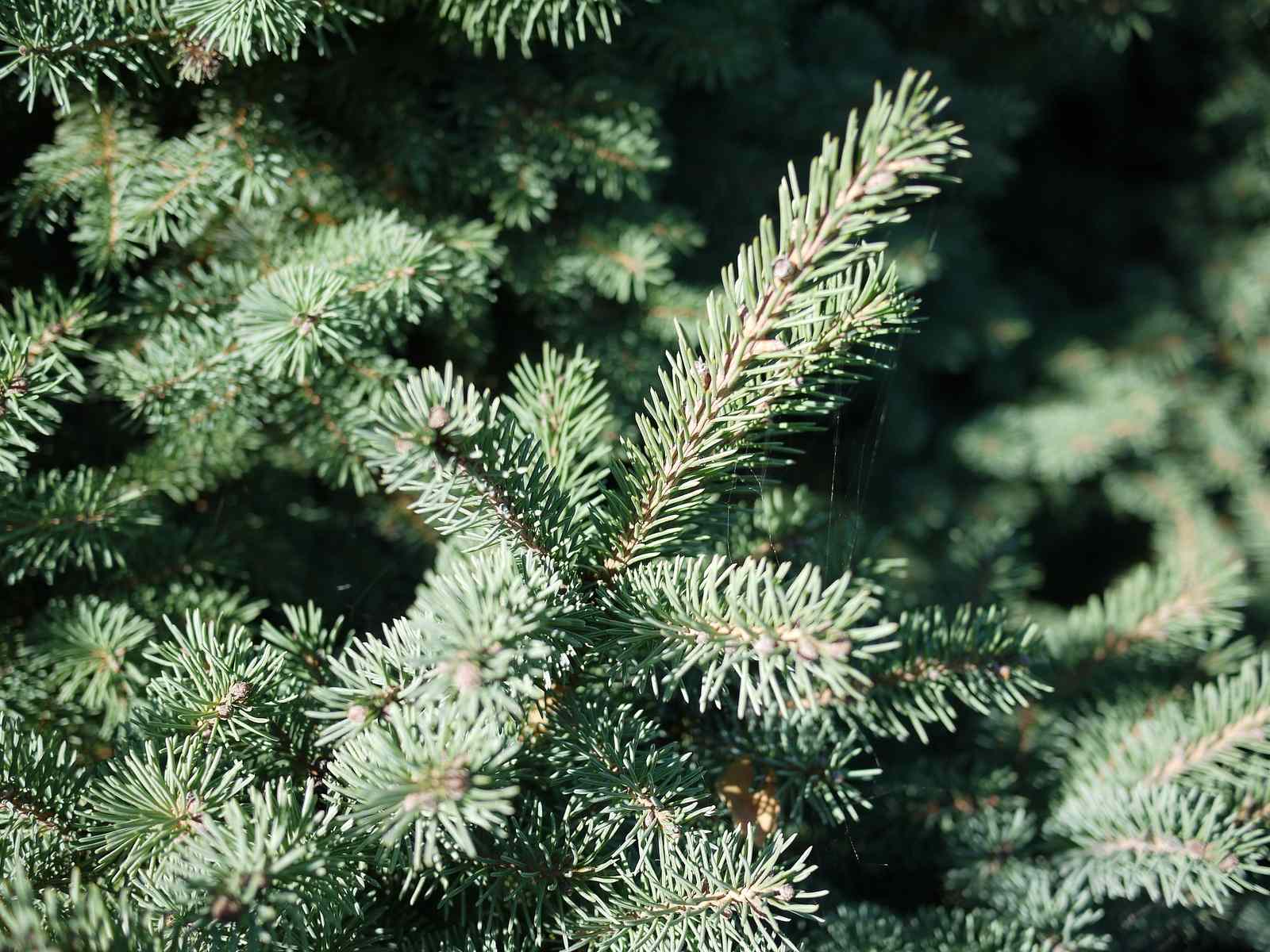
White Spruce bark: rough grey bark
About White Spruce:
- Indigenous people used warm White Spruce gum as glue. White Spruce is also now often used for lumber and pulp.
- White Spruce can grow to be as old as 1000 years.
